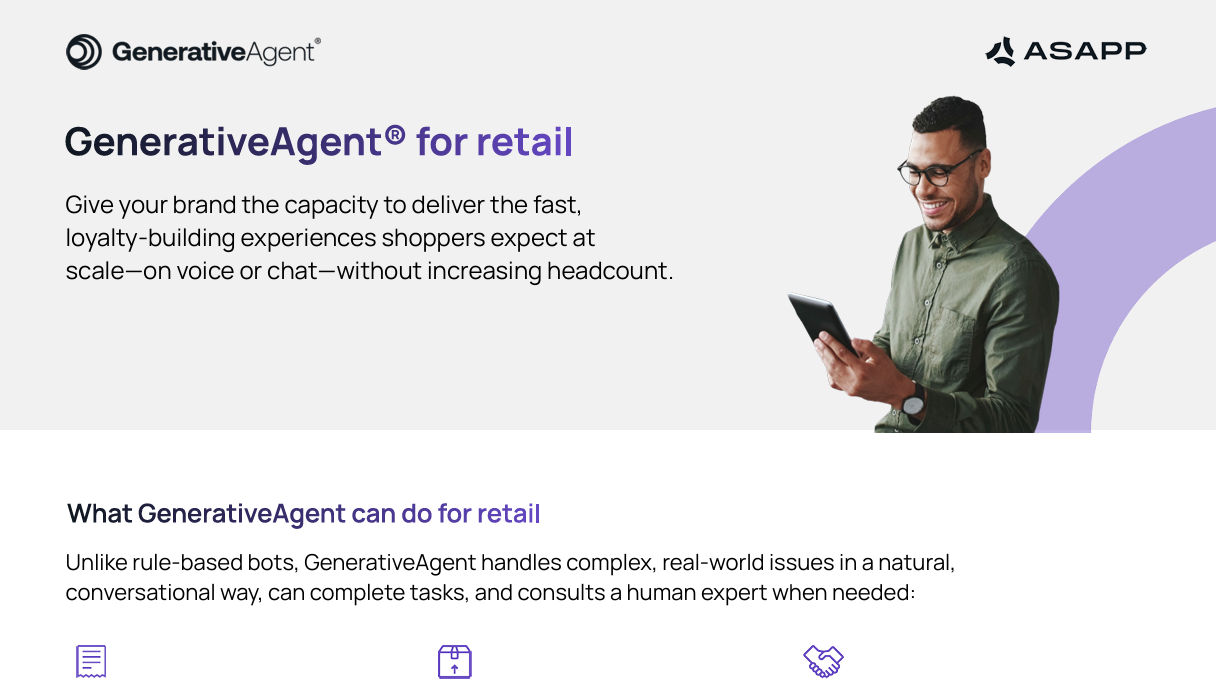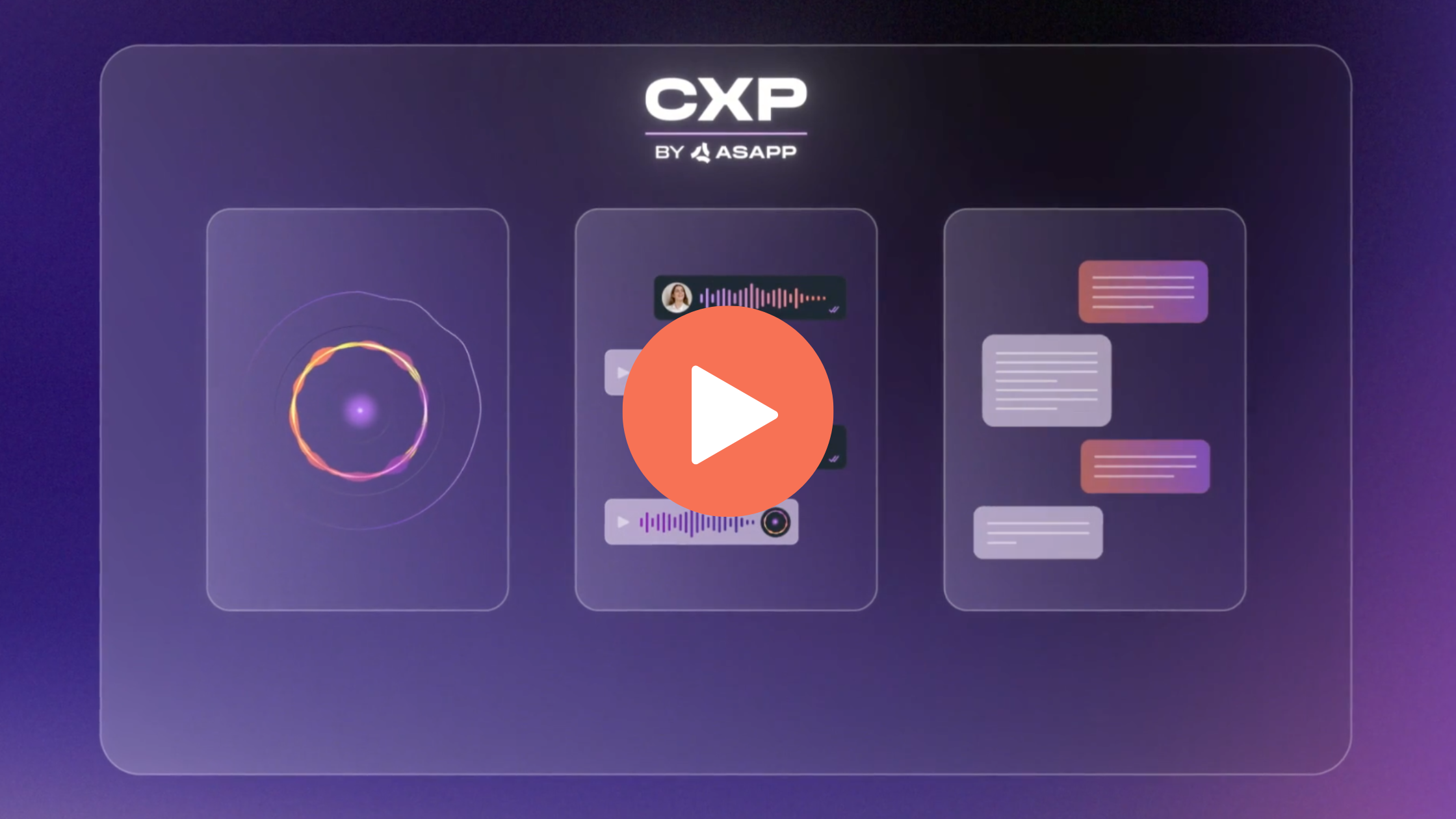Theresa Liao

Theresa Liao leads initiatives to shape content and design at ASAPP. With over 15 years of experience managing digital marketing and design projects, she works closely with cross-functional teams to create content that helps enterprise clients transform their customer experience using generative AI. Theresa is committed to bridging the gap between complex knowledge and accessible digital information, drawing on her experience collaborating with researchers to make technical concepts clear and actionable.
AI customer service agents: how CX leaders select the right use cases
Selecting the right use cases is one of the most important decisions CX leaders face when deploying generative AI agents in customer service. Good use case selection can demonstrate value and ROI, secure internal support, and provide insights that streamline future deployments.
So how do leaders decide where to start? Here’s how they prove value, set priorities, and keep customers at the center in their own words.
Lay the groundwork with the right data

James Dill, Digital & AI Transformation Specialist, Assurant
From AI-enabled to AI agents: A strategic on-ramp for your contact center
I know a lot of companies, ourselves included, tend to look at data as almost a subfactor of performance instead of true performance. There's a lot of bottom dollar type savings, but there are a lot of metrics that inform the rest of the experience that can really help all of those metrics grow as you do. So make sure you have the right data, the right visibility, and the right information. I mean, that's really the groundwork we've been able to look at for any new implementation. Check those boxes, and you're good to go.
With data as the foundation, you can then look at how to prioritize which problems to tackle first.
Filter by containment, complexity, and customer hot-button issues
Director, CX Digital Transformation, Fortune 500 Airline
We had a lot of intents we could look at in terms of data, especially those with lower containment. Then we added the lens of complexity, and finally, what we felt were the most pertinent problem statements from a customer perspective—the hot-button topics. When you create that intersection, the right intents start to fall out. That’s the filtration process we used for the short list you see here.
After narrowing down your focus, the next challenge is how to actually begin deploying AI against those use cases.
Start small and prove it out

Harry Clapham, Director of Operations Strategy and Enablement at Tangerine Bank
Tangerine’s Path to Agentic AI: Building Better, Smarter CX in Banking
It's important when you deploy these technologies, you pick, you know, the right limited use case. Maybe it's an FAQ. Maybe it's a transactional use case. You prove it out, and you expand over time.
What might be smarter is if you can get a goal on the board or get a score on the board, which might be a simpler use case, but you show that it gives the returns that you're saying it will, that everybody's comfortable with the risk. It might be internally facing to begin with, but you're still proving out how generative AI understands human prompts. There's a whole other learning you can obtain that applies to future use cases, but your starting point has been kind of cognizant of the concerns around the table, but you're getting points on the board.
Harry emphasizes here the principle of getting “points on the board.” James reinforces this with specific examples of what that looks like in practice at Assurant.

James Dill, Digital & AI Transformation Specialist, Assurant
From AI-enabled to AI agents: A strategic on-ramp for your contact center
What's the lowest-hanging fruit of queries that customers have for us that can be solved by a generative agent—whether that be a question about their terms and conditions, the status of their claim, or filing a new claim? We think about the low-hanging fruit and the eighty percent of interactions we have that could be addressed via a generative agent. And we've also considered those instances where the generative agent can help get you ninety-nine percent of the way there, but a human still needs to make the final decision.
Alongside data and smart piloting, people play a critical role in identifying the best use cases.
Bring your people with you

Nikki Schmidt, Director of Technology Services, Assurant
From AI-enabled to AI agents: A strategic on-ramp for your contact center
Bring your people with you. Your agents are a wealth of information. Your business partners are a wealth of information. Nobody does not have value in this discussion, and especially those who are on the front lines of your systems, your day-to-day. They're gonna know the best about your data, about your knowledge bases, about what's happening with your consumers.
With the right people and data aligned, the focus turns to what matters most: the customer.
Focus on reducing friction

Steven Canterbury, Director, Customer Success Management, ASAPP
The AI ROI equation: balancing operations, costs, and better CX
The biggest thing I’ve seen from companies doing AI strategically is that they’re focused on reducing customer friction—making it easier for customers to get to a resolution, whether through self-service, faster access to an agent, or shorter queue times. The real goal of delivering AI right now is reducing that friction in the first place.
That focus on friction becomes especially important in moments of disruption, where AI can help manage scale and speed without sacrificing experience.
Turn disruption into faster resolution: an example

Steven Canterbury, Director, Customer Success Management, ASAPP
The AI ROI equation: balancing operations, costs, and better CX
We worked with an airline that delivered an AI solution to identify when customers were impacted by a disruption and let them rebook on their own, with natural interactions. The result: higher containment, faster resolutions, and freed-up agents for complex issues. For disrupted customers, live-agent resolution took about 25 minutes end-to-end. With the generative AI solution, it took just eight.
Why use case selection matters
For CX leaders, selecting use cases isn’t just a starting point. It is an important decision in deploying AI agents. These perspectives show that the best use cases aren’t the flashiest ones, but the ones that reduce friction, prove value, and solve real customer problems. The organizations that succeed are disciplined in how they evaluate, practical in how they deploy, and always grounded in what matters most: improving the customer experience.
7 questions on selecting best AI customer service agent use cases
AI customer service agents hold the promise to finally address long-standing contact center challenges by delivering faster resolution, reducing handling times, and driving greater efficiency.
But Gartner recently estimated that more than 40% of agentic AI projects will be scrapped by the end of 2027. The report emphasizes that the success or failure of these projects hinges not on the technology itself, but on selecting the right use cases that deliver value and ROI. Choosing wisely ensures early wins and helps avoid costly missteps that can derail broader adoption.
“To get real value from agentic AI, organizations must focus on enterprise productivity, rather than just individual task augmentation.” —Anushree Verma, Senior Director Analyst at Gartner.
Here are seven questions to help guide your selection of the best AI customer service agent use cases
1. Why is it important to start with the right use cases?
Starting with the right AI customer service agent use cases is critical for building trust and momentum. Early wins generate excitement and internal buy-in, proving the value of the technology. If the first attempt fails—even because of poor selection rather than limitations of the AI—it can derail future initiatives.
For smaller organizations especially, demonstrating value early on helps justify the resources needed for more advanced integrations or new APIs. Some companies begin with knowledge base scenarios, which offer relatively quick wins and help establish early confidence in AI customer service agents.
2. What are the most common misconceptions about AI customer service agent use cases?
A frequent misconception is that AI customer service agents can handle “everything under the sun.” In reality, they should be reserved for problems that traditional IVRs or virtual agents cannot address. Applying them to simple, well-covered issues only adds complexity and cost.
Another misconception is that high call or chat volume automatically makes a use case a good candidate. Volume alone doesn’t guarantee success. The better approach is to look for issues customers want to solve independently but currently cannot, where AI customer service agents can unlock real resolution.
3. Why do these misconceptions persist?
Misconceptions often stem from two sources: vendor hype and internal wishful thinking. The rapid pace of AI innovation amplifies these expectations, making it essential to separate hype from reality before selecting use cases.
4. What prerequisites should organizations have in place?
Organizations need a clear understanding of what’s happening in their calls and chats before selecting use cases for AI customer service agents. This includes knowing which issues escalate to live agents, what actions agents typically take, and what questions arise most often during escalations.
This information ensures that use cases are both frequent enough to matter and solvable with existing APIs, knowledge, or newly built tools. Discoverability analyses can support this effort, especially when there’s access to large volumes of conversation data.
It’s also important to involve someone with deep API expertise early on. A common misconception is that you can simply plug APIs and a knowledge base into an AI customer service agent and expect it to perform. In reality, thoughtful preparation and integration work are essential.
5. What distinguishes good from bad use cases?
Good AI customer service agent use cases typically share these characteristics:
- Traditional virtual agents cannot handle the complexity due to many possible API outcomes.
- Broad policies with nuanced exceptions require human judgment.
- Conversations follow non-linear paths, with questions branching in multiple directions.
- There is a clear path to resolution, minimizing abandonment risk.
By contrast, bad AI customer service agent use cases often involve:
- A lack of content or policy information to support answers.
- Problems that fundamentally require human intervention, such as physical device takeover.
- Flawed underlying processes that AI cannot fix.
- Customers consistently insisting on speaking with a human.
6. How should success be measured?
Measuring success begins with safety and accuracy. Early implementations of AI customer service agents should focus on mistake monitoring to ensure the system behaves as intended.
Once safety is confirmed, success should be evaluated by resolution: Are customer issues being fully resolved? If not, is the AI significantly reducing handle time through human-in-the-loop scenarios? Importantly, success should not be confused with deflection. A customer hanging up or escalating to a live agent without resolution does not count as success.
When metrics fall short, the issue may lie in the use case selection itself or may require optimization—such as adding content, refining workflows, or adjusting the level of human involvement.
7. What are “human-in-the-loop” use cases?
Human-in-the-loop use cases involve collaboration between AI and humans at critical points in the workflow. At ASAPP, our unique Human-in-the-Loop Agent (HILA™) workflow focuses on human agents supporting AI, instead of traditional contact center escalation. Here are two scenarios that HILA use cases make sense.
- System Access Limitations: The AI identifies an issue but does not have permission to resolve it. A human steps in briefly, after which the AI agent continues the interaction.
- Business Decisions: Even if AI can handle the initial steps, organizations may require a human to make final decisions on sensitive actions. In these cases, the AI agent gathers and processes information, and a human agent makes the final judgment.
This model underscores that AI is not replacing human agents, but working alongside them. It also has important implications for workforce management, requiring thoughtful design of human-AI collaboration.
Conclusion
Selecting the right AI agent use cases for your contact center is an important first step in any deployment. It requires preparation, clear evaluation criteria, and a commitment to separating real opportunities from hype. While it may seem like additional upfront work, the payoff is enormous. AI customer service agents are not “set it and forget it,” but when implemented thoughtfully, they deliver value and ROI that far outweigh the effort.
Inside the AI agent failure era: What CX leaders must know
The failure rates are staggering
Recently, an MIT report, The GenAI Divide: State of AI in Business 2025, grabbed attention. It found that only 5% of enterprise-grade generative AI systems reach production—meaning 95% fail during evaluation. Another report from Gartner suggested that 40% of agentic AI projects will be scrapped by 2027.
And in simulated office environments, LLM-driven AI agents get multi-step tasks wrong nearly 70% of the time.
Agentic AI—long thought capable of automating most contact center workflows and repetitive tasks—is starting to look like it could turn into a bad science experiment. And these won’t be the last reports of AI agent failure in contact centers.
The causes aren’t random
But why? These failures are not random. Both MIT and Gartner point to similar root causes: projects driven by hype, poor alignment with real workflows, and weak governance or risk controls. MIT calls it the “learning gap”: enterprises don’t know how to design AI systems that actually learn and adapt, so most pilots stall out. And Gartner highlights rising costs, unclear value, and a market flooded with “AI agent–washed” products.
The reality is that enterprise adoption demands more than LLM-driven agents; it requires systems built to integrate, adapt, and improve over time.
Why listen to a marketer?
So you might ask: Why keep reading a blog post written by a marketing professional, especially one who represents an AI for customer service company?
Because it’s my job to read the market. And that means keeping up with the marketing trends. Here’s what I see. The hype and the noise in the customer service AI market make it much harder for truly innovative solutions to be heard. I see some vendors exploiting the confusion by “AI agent washing” their solutions. I hear about AI agent systems that can’t do basic knowledge retrieval or connect to existing CCaaS reliably, yet still end up on many buyers' short lists simply because they’ve made grand promises on paper.
That makes it harder for you to find the right solution—and harder for those of us with successful enterprise deployments, who have taken the time, effort, and expense to refine the process and improve real-world results, to get our message across.
In this blog post, I want to share some of my own observations about the market and what you should know about AI solutions and platforms for CX.
An example of AI agent washing
Case in point: I recently came across an ad on Instagram promising an AI customer service agent with on-brand responses and “no hallucinations.”
The process seemed simple: import content from your website and knowledge bases, test how the AI agent responds in a chat window, and then, supposedly, activate it. Voilà—problem solved!
Except that’s not how it works. Far from it.
Here’s where the marketing confusion comes in. Most customer-facing AI agents are generative, because that’s how they create a conversational experience without relying on predetermined flows. But, that’s also why they inherently would hallucinate. The risks, though, can be dramatically reduced, but never reduced to zero. If you are interested, this blog post written by my colleague Heather is a great read to get a better understanding of hallucination and strategies to properly manage it.
And you can’t simply ask a generative AI agent a few test questions, get a correct answer, and declare the agent ready to go live with your customers. Safety requires much more robust testing, including simulated real-world scenarios, along with continuous monitoring and safeguards. A simplistic one-time check won’t cut it.
I dug into the website for this particular solution, and indeed, nowhere did they claim to use generative AI. So, of course, it doesn’t hallucinate. That likely means this so-called AI agent relies on natural language processing (NLP) to determine customer intent, and then follows deterministic flows. It completely lacks the power of a true generative AI agent.
And that takes us to a word that vendors can take advantage of, especially in CX: agent. In my mind, the name “AI agent” implies the solution is “agentic” and therefore, capable of taking actions autonomously without or with minimal human guidance. With this particular so-called AI agent, there is zero indication that it’s capable of any autonomous action. The word agent is used simply for its current marketing power, positioning this CX bot alongside more capable generative AI agents for customer service.
So, at the end of the day, this “AI agent” is just an “AI agent–washed,” glorified chatbot—neither generative nor agentic.
Navigating the CX AI agent marketplace
As fast as this confusing AI agent market is moving, choosing not to deploy an AI agent is not ideal. More organizations are taking advantage of AI agents every day, and the 5% who get the deployment right will gain a tremendous advantage over their competitors.
So, here are a few things you can do to move forward safely and protect yourself against the marketing tactics I’ve mentioned, directly from a marketing professional.
1. Question the terminology
When vendors tout their solutions as an AI agent for customer service, investigate what they mean. Does the AI agent leverage generative AI? Or just some kind of AI (e.g., NLP)? Is it truly agentic, or does the vendor focus primarily on its conversational nature? If it is agentic, does it simply retrieve information to serve up to customers, or is it connected to other systems through APIs so it can act to solve customer issues?
For AI customer service agent platforms, if the vendor says they keep a human in the loop, does that mean human agents are still just an escalation point for an AI agent that’s incapable of acting autonomously? Or does it mean there is a structure in place for human agents to step in and guide the AI agent, without taking over the interaction completely—so the AI agent is still largely autonomous?
We put together a short guide that we’re still expanding to better explain some of these terms that you definitely want to keep in mind when you’re evaluating vendors.
2. Look for proof
You can find proof that a company has a strong vision and the technological maturity to deliver innovative solutions in a few places. But keep in mind that the agentic AI platform market is still young, which means you’ll need to look beyond the most obvious sources to spot reliable vendors.
Analyst reports
Look for companies that are cited in analyst reports for their direction and vision, as well as their technology and ability to execute. This indicates that the company actually thought through the deployment and understands the impact of the deployment.
Analyst reports with vendor evaluations are also a reliable source of information, but keep in mind that the research cycle for those can typically be long, and some innovative players will be noticeably missing from the reports that are coming out just now.
Enterprise customers
Enterprise logos are another good piece of evidence the vendor is trusted, but also keep in mind that large enterprises are sometimes reluctant to reveal their use of AI technologies, given that this is still a new market. So, look beyond the logos on the vendor’s home page to see if the vendor has customers who appear at events or presentations with them. The willingness to share a stage with the vendor is a kind of endorsement of their product.
Case studies
See if vendors have case studies that cite concrete outcomes, specifically ones reported with mission-critical CX metrics, and not just fluff pieces that talk broadly about the vendor’s products. Similarly, look beyond names and logos. And focus on whether the case study is based on a product that’s live in production, and not just an internal deployment in a safe environment without the stress test of the real world. You’ll need to read between the lines.
3. Meet with vendors as early as possible
Once you put together a shortlist of AI customer service agent vendors, meet with the vendors as early as possible. There are three big reasons not to delay.
One, a conversation can easily reveal whether the solution is just a prototype or a mature platform working in production. You will also have better insights on reference customers beyond what’s visible publicly, and understand their deployment process.
Two, you can connect your stakeholders with the vendor early. Selecting an AI solution usually involves multiple stakeholders; a vendor with experience can help facilitate your internal conversation and answer questions other stakeholders have early on. It will also help you gather internal momentum and support.
Three, some clear red flags are much easier to spot after a chat with a vendor. For example, stay away from vendors who:
- Can’t provide reference clients or production use cases.
- Focus only on headcounts, and promise to replace all your human agents.
- Push you to hand over all customer interactions, instead of focusing on the use cases where AI agents will excel.
- Can’t articulate how their solution delivers value and concrete CX outcomes, beyond “sounding human.”
- Do not offer any POV, free or paid.
4. Make sure the vendor offers POV
Doing a Proof of Value (POV) is the only way to validate the technology and to learn if the AI agent works as intended (vs. one that just looks good on paper). It gives you insights into whether the AI customer service agent can successfully integrate with your existing tech stack and what resources are required to deploy a use case. Finally, you will also get a chance to work with the vendor team and better understand whether they will just leave you with a broken toy, or provide expertise and knowledge to carry you through the process.
Doing a POV is incredibly important, especially given AI agent platforms are relatively new to the market. If a vendor doesn't offer one, then you have to take on the risk of committing to the vendor before knowing whether their technology is mature enough to safely and reliably handle real customer interactions. And given AI investments typically require stakeholders across departments, a failed project can cause real damage to internal support for AI systems and make it even more difficult to rally for future projects.
Some vendors offer a free POV, while others offer paid ones. Consider the following pros and cons.
Free POV:
- Low barrier to entry, fast experiments
- Usually limited in scope, or with a use case that doesn't fit what you really need
- Could have lower vendor commitment, as they are not getting paid
Paid POV:
- Requires budget allocation, more internal approval
- Usually clear delivery timeline, milestones, and resource commitment, as the vendor is paid and motivated to deliver
- Usually a more realistic environment with deeper integration, which is necessary with agentic AI evaluation in CX
Finding the path forward to 5%
While the MIT and the Gartner reports highlight today’s failure rates, there is a clear path to the 5% with successful pilots leading into production. I expect this number to grow soon as companies have a better understanding of how to identify and deploy AI solutions in an enterprise environment, and those who do this well, early, will leverage AI as a powerful tool and have a full advantage over their competitors. By demanding clarity on terminology, validating vendor claims with proof, meeting vendors early, and insisting on a POV, you can move forward with an AI solution that truly addresses your contact center challenges—and delivers both CX outcomes and business value.
Precision under pressure: What to look for in a customer-facing AI agent platform
Despite the growing number of tools to build AI agents, putting one in front of customers is still a high-stakes commitment.
That’s because customer-facing AI agents do not operate in controlled environments. While someone might easily spot and correct a mistake from an internal-facing AI agent, public-facing agents don’t get this luxury. An error could mean a frustrated customer, a compliance breach, or a viral failure that costs the company its reputation and public trust. And because generative AI doesn’t follow deterministic rules, you’re not just coding logic. You’re managing how the AI agent behaves—at scale.
So in addition to looking at specific features, performance metrics, and business outcomes, you will also need an infrastructure that allows you to test, train, monitor, and govern your AI agents before and after they go live. These capabilities shouldn’t be afterthoughts; they are must-haves. Here are the three to start with.
1. Tools to test AI agents with simulated, realistic customer personas and scenarios
You will need to stress test your AI agent with an array of customer personas and scenarios that mimic real interactions AI agents will face before anyone ever clicks on “chat now.”
Look for platforms that go beyond simple sandboxes to offer fully baked test environments where your team can run multi-turn conversations that simulate real customer interactions. Think QA lab, not one-off demo.
There are a few things that you want the simulation tools to help you test:
- Ability to escalate to human agents so customers don’t get stuck in the doom loop
- API calls and data retrieval to return valid information
- Policy enforcement and compliance cases
- Edge cases, ambiguous prompts, or off-brand language
The tools shouldn’t just confirm success. They should show where and how the AI agent fails so you can fix it before it goes in front of customers.
To set up realistic scenarios, your customer service and ops teams must be involved. This is where no-code tools are valuable. If your CX team can create and modify test cases without engineering support, you’ll roll out faster and free up technical teams from doing work others are already equipped to handle.
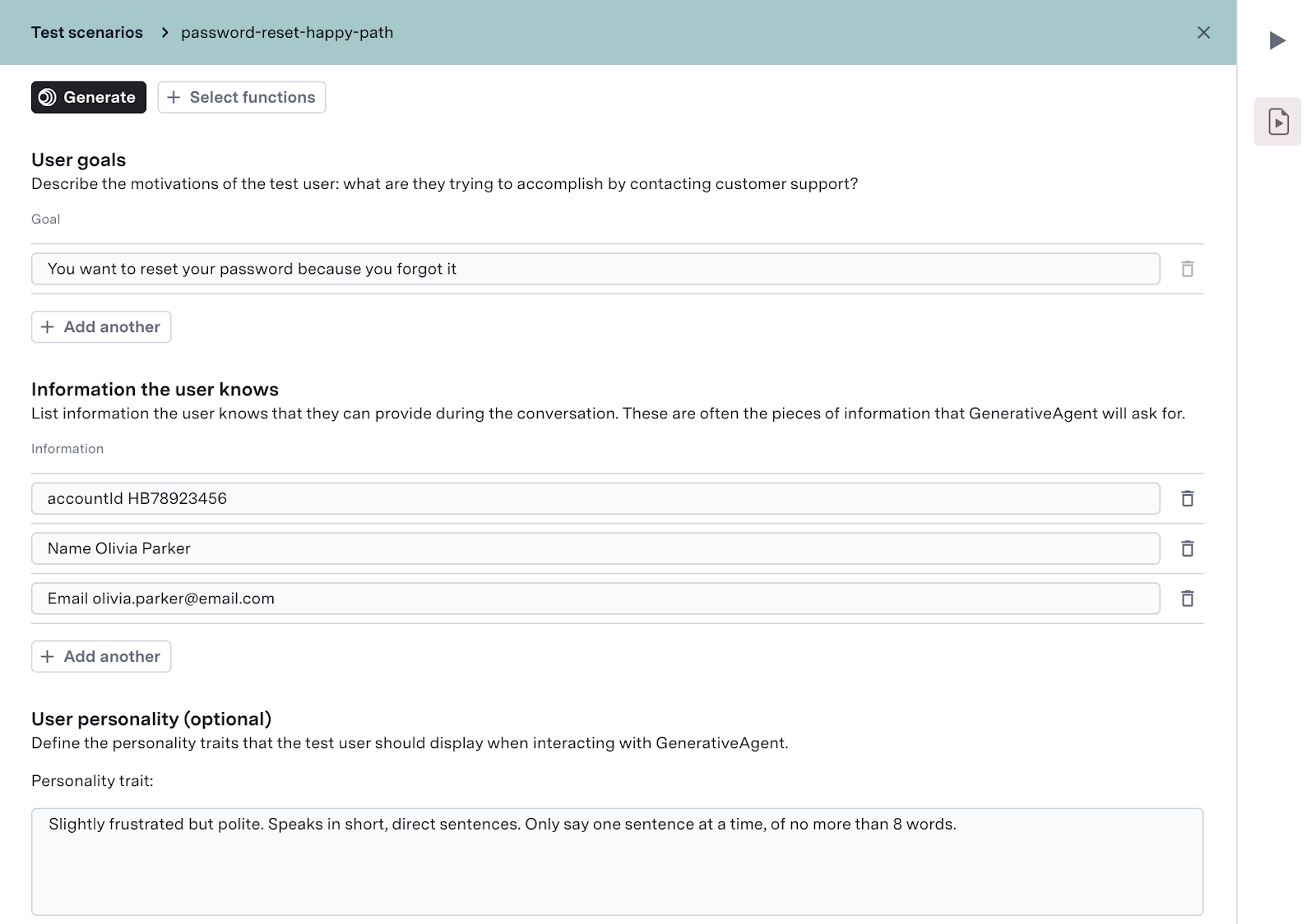
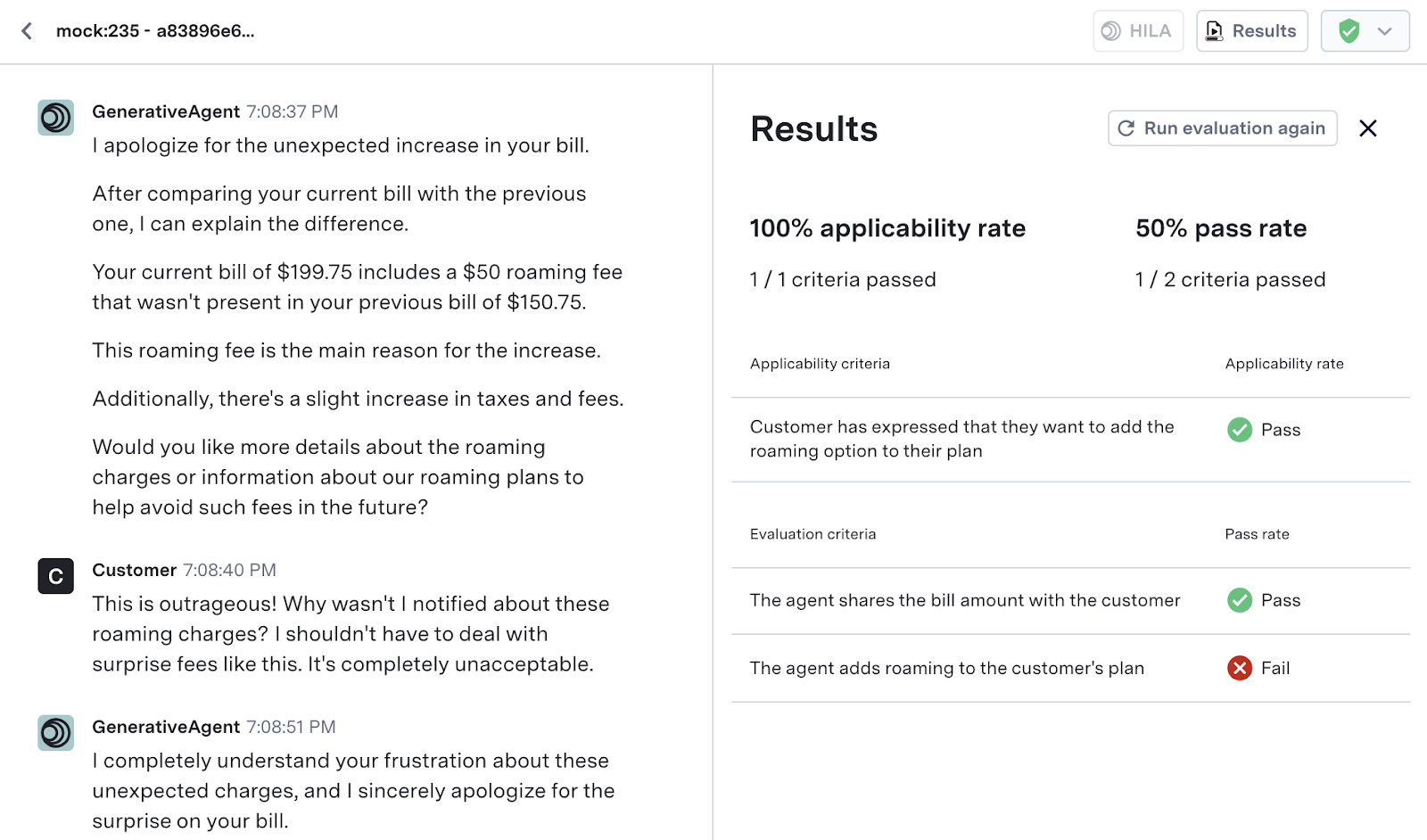
2. Meaningful human oversight not for AI agents to punt problems to, but for them to learn from
Most have now accepted that having a human in the loop is a necessity for customer-facing AI agent deployment. Few are actually doing this meaningfully. It’s easy to say, “When an AI agent doesn’t know what to do, punt that customer to the human agent,” but that’s not really leveraging what the AI agents can achieve: to ultimately automate as much of the contact center operation as possible and leave humans to handle cases where human judgments are necessary. This is why many AI agent deployments only show incremental improvements, because the human-AI collaboration workflow was never thought through.
A much more meaningful collaboration workflow is to give the AI agent the connections and access necessary (securely, of course) to address customers’ issues, and for it to know enough to reach out to a human agent for help. Or, in some cases in regulated industries, to be required to pass the customer on to a human agent with all the available context already at hand. For this to happen, one must consider the agent interface for AI to interact with human agents.
But we can go one step further. As contact centers look to expand more use cases to launch with AI agents, a human agent can “shadow” the AI agent and provide real-time feedback that will become training data. In a way, this mimics how new agents are being trained on the job. This not only gives companies full control when AI agents are being deployed. It allows AI agents to be trained and refined quickly through live or asynchronous coaching through real interactions.
So the human agents are not stopgaps. They help train the AI agent to facilitate rollout and fine-tune its behavior.
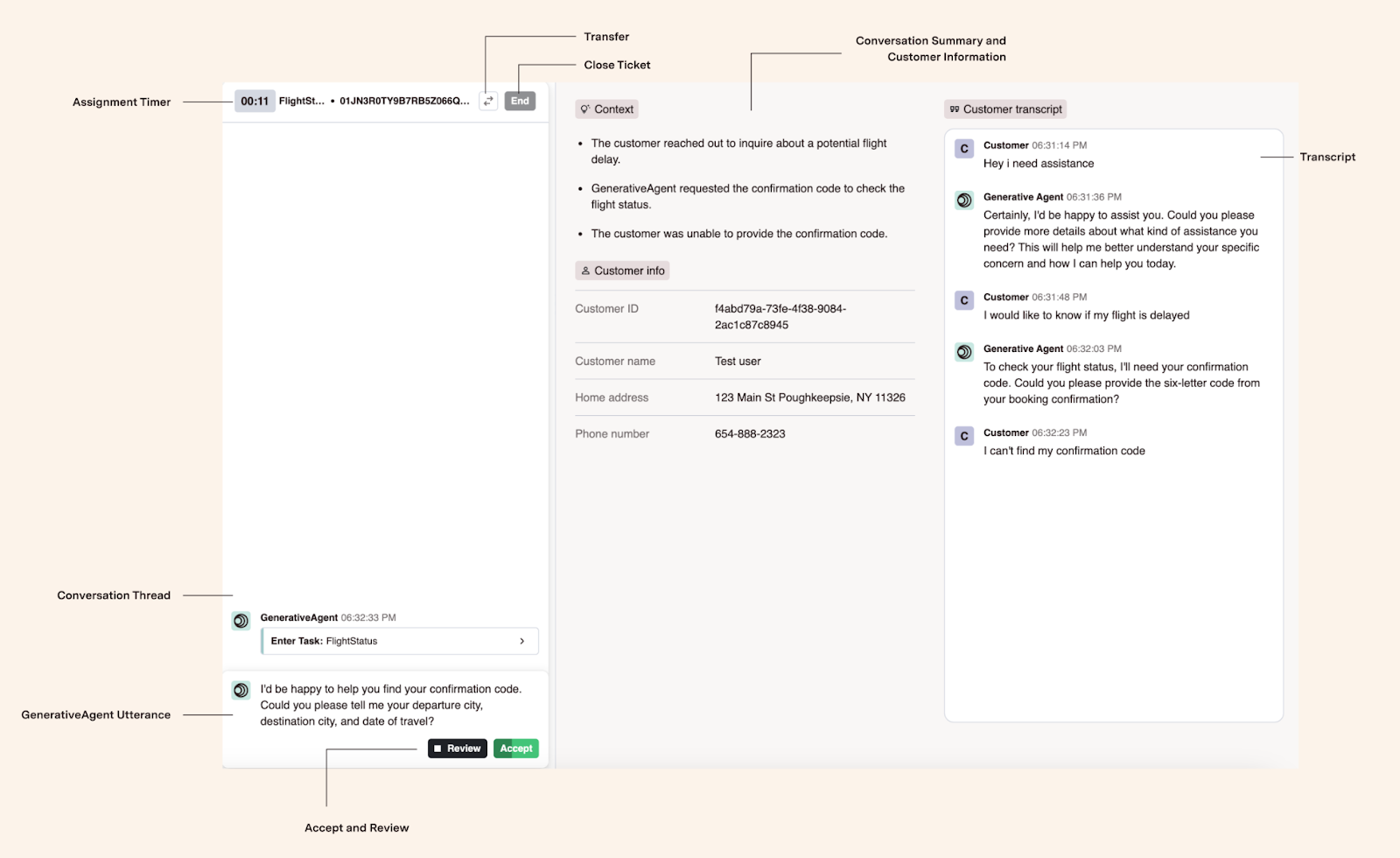
3. Full visibility into AI behavior and the reasons behind, with automated flagging of issues
The work with AI agents isn’t done when you deploy it. It’s only just started. To continue refining AI behavior and to be able to correct any errors or unusual behavior, you first need to have visibility into what the AI agent does and why it does so.
For example, if an AI agent issues a refund to a customer by mistake, you will need to first be able to spot the mistake, and why it made the decision to refund the customer. Is there an issue with a knowledge base article? A problem with an API connection? A no-refund policy that wasn’t adhered to—and if so, why? You can’t tackle the problem or course-correct the AI agent without knowing exactly why it made the decision. So, full visibility is absolutely necessary to deploy and maintain trust in the AI agent.
Similarly, let’s go one step further. As you scale your AI agent interactions, you will very quickly face an issue with the volume of interactions. You simply can’t review all AI interactions anymore. With this, you must build in a mechanism into the system that will flag unusual behavior automatically. So, you’re not only automating interactions. You are also scaling the QA of contact center operations. Some examples that your system should flag automatically include:
- Compliance violations or risky language
- Repeated failure patterns or fallback triggers
- Brand voice inconsistencies
- Escalation trends over time
Again, you can’t fix the problem if you don’t know it exists in the first place, or why the problem exists. Of course, these monitoring tools will only give the context and the problem—these insights must be turned into actions in order for your team to continue improving AI agent behavior.
And it’s also how you scale trust. If you can’t explain what your AI is doing and why, you can’t defend it to regulators, customers, or your own stakeholders.
You shouldn’t scale what you can’t trust. And you can’t trust what you can’t see.
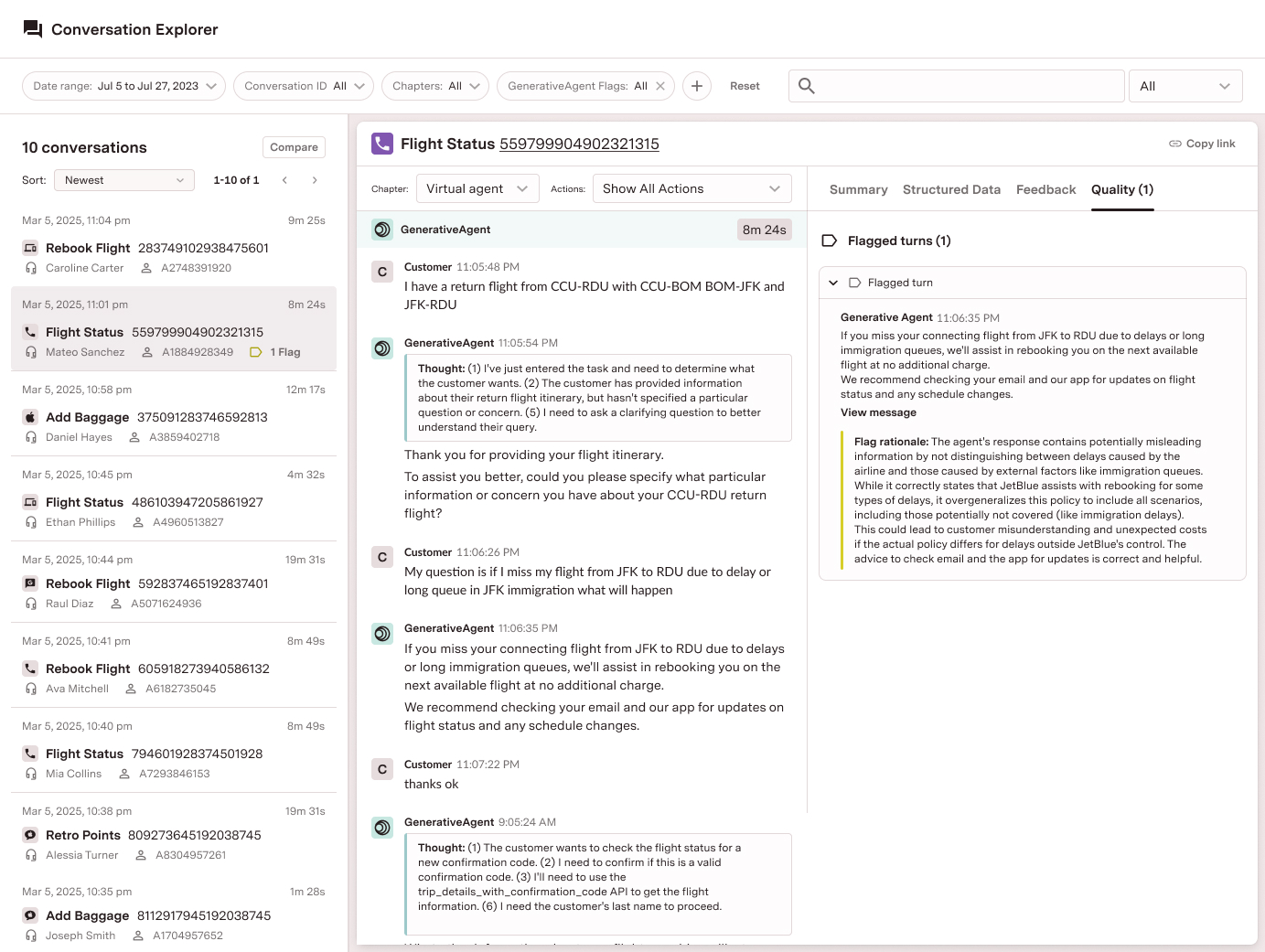
See how leading vendors are raising the bar
ASAPP is setting a new standard for what customer-facing AI should look like.
Its GenerativeAgentⓇ is a platform built from the ground up to handle complex, multi-turn conversations with enterprise-grade performance, safety, and control. Its latest release includes features that will elevate trust and precision in AI-automated customer conversations:
- Human-in-the-Loop Agent (HILA) with Approver Mode: Enables faster resolutions and better outcomes by allowing human experts to review and approve AI responses in real-time or asynchronously, fine-tuning and improving accuracy and agent learning over time.
- Conversation Monitoring and Fine Tuning: Achieve full visibility into AI interactions with intuitive tools to flag anomalies, track patterns, and enforce compliance with customizable guardrails for quality assurance at scale.
- Testing and Simulation: Safely test AI behavior in simulated environments to release updates into production with confidence, increasing control, transparency, and trust in automated interactions.
But this is all part of a bigger vision for a true agentic ecosystem with self-improving, assistive, and enterprise-aligned AI.
The future of customer service starts with infrastructure that makes AI safe, precise, and accountable—by design.
8 high-impact use cases for AI agents in retail customer service
Customer service teams in retail are constantly under strain to deliver, facing higher customer expectations, more complex interactions, and increased pressure to reduce operating costs further. CX models that put the burden squarely on human agents or rely on basic bots can struggle to keep up with the massive demand for high-quality service.
That’s where generative AI can be effective—if used right. Unlike legacy automation tools, generative AI agents have the capability to respond to customer needs in real time and take actions to resolve customers' problems—from cancellations and refund requests to answering nuanced product questions. Instead of a rigid, pre-determined conversation flow, AI agents can respond naturally and resolve issues quickly throughout the customer journey.
An important first step is to identify and choose the right use cases to get the most out of these generative AI agents. This will not only allow you to prove the value of deployment quickly, but also rally internal support to expand use cases.
Here are 8 high-impact use cases where you can benefit the most by putting generative AI agents to work in retail:
1. Streamlining returns, refunds, and exchanges
Returns and refunds are among the most common (and often the most frustrating) customer service interactions. Nobody wants to be put on hold or be stuck with a chatbot after receiving the wrong product or something that doesn’t meet expectations. What customers want at that moment is a fast resolution to get their money back.
Instead of a long wait, customers can receive help from a generative AI agent immediately to complete their requests. With access to backend systems and your knowledge base, autonomous AI agents can check return eligibility, verify order details, generate a shipping label, and even suggest exchange options—all in an experience that’s straightforward for customers.
This turns a potentially bad experience into a quick, easy conversation, helping you gain customers’ trust and encouraging them to return in the future.
2. Answering order questions—before escalation is needed
“Where’s my order?” doesn’t have to lead to long wait times, endless prompts, or email back-and-forth. A generative AI agent can retrieve real-time order status, handle delivery delays, and even update shipping details—no awful hold music or frustrating menu navigation required.
If things do go wrong, like missing items or shipping errors, an AI agent can also help triage and resolve issues on its own, or if needed, seamlessly hand off the interaction to a human.
Taking it one step further, the AI agent can provide all the necessary context of the customer conversation, so the human agent can pick it up where things were left off without asking, “Can you repeat your order number again?”
3. Scaling effortlessly during seasonal peaks
Holidays, promotions, and new product launches can significantly drive up call and chat volumes, making it both difficult and expensive to predict and keep up with demand.
Because an AI agent can scale automatically when demand surges, it can handle thousands of conversations simultaneously. This means that when customers call in, their calls are answered right away. This helps teams maintain a high level of service even during peak times while preventing loss of revenue due to customers waiting too long to get answers.
This also helps teams avoid over-hiring or burning out the existing customer support team.
4. Enabling upsell opportunities
One of the most overlooked benefits of AI-driven service in retail is its ability to drive revenue. When customers reach out for support, a generative AI agent can reliably suggest complementary products, highlight current promotions, and guide customers toward relevant purchases. This is especially helpful for companies with extensive product catalogs.
For example, if a customer returns an item and needs help finding a replacement, the AI agent can make personalized recommendations and even handle the purchase if integrated with the necessary systems.
5. Making loyalty programs more accessible
Loyalty programs are only effective if customers understand them and can use them easily, without confusing rules or difficult enrollment steps. An AI agent can help make these programs much more accessible by explaining how the rewards work, checking point balances, enrolling customers, and applying promotions.
This makes it easier for customers to take advantage of the program and, in turn, helps the company build real customer loyalty.
Even during high-volume periods, the AI agent can consistently offer loyalty options without increasing pressure on frontline teams.
6. Handling product and policy questions with context
Customers don’t always stick to the script. They ask real questions that demand more than predetermined conversation flows: “Is this jacket available in my store?” “Can I use a coupon on this sale item?” “Will this remote work with my smart TV at home?”
Generative AI agents can answer these questions in plain, natural language by referencing the company’s data, policies, and inventory in real time. Even if rules vary by region or product category, or if they were updated just yesterday, the AI agent can keep up, without getting confused or sending customers in circles.
7. Providing always-on, around-the-clock support
Customer questions don’t stop after hours—and generative AI doesn’t stop serving, either.
AI agents are always available, whether it’s a midnight delivery issue or a Sunday search for the right product. This availability not only improves customer satisfaction, but also helps reduce pressure on your after-hours teams and prevent long hold times during nights or holidays.
8. Delivering consistent, brand-aligned experiences
Maintaining consistency across channels, locations, and agents is a constant challenge for retail contact centers, especially when agent turnover is high.
A generative AI agent can deliver consistent, on-brand service by drawing from the company’s knowledge base, product catalog, and policies. Whether it’s answering a shipping question or suggesting a product, it provides accurate, reliable responses. It can also personalize them using customer history or preferences when available.
What to look for in a generative AI agent for retail
If you’re exploring generative AI agents, focus on practical capabilities, not just hype. Here are three things to look for:
Easy API integration
AI agents should plug into your existing systems, such as order management, CRM, inventory, and loyalty, without weeks of custom development. Solutions that support flexible API integration, including tools for API transformation or adaptation, will make it easier to connect even with legacy systems.
When integration is limited, look for solutions that support human-in-the-loop collaboration with an intuitive workspace, so a human expert can support and guide the AI without completely taking over the interaction.
Human-in-the-loop capabilities
Not every conversation requires escalation. But sometimes a bit of human input can make all the difference. Choose AI agents that allow for real-time human-in-the-loop expert guidance without interrupting or handing off the customer interaction entirely.
Built-in QA and analytics
To scale successfully, you need visibility. Look for AI platforms that include robust conversation analytics, quality assurance tools, and clear insights into what's working and what’s not. That way, you can continuously refine and optimize your AI agent’s performance based on real data.
Testing and simulation
Due to its generative nature, you can’t spot check an AI agent and call it a day if the first handful of responses meet your expectations. Look for a solution that provides ways to set up realistic customer interaction scenarios. It’s even better if these tools are no-code, so you don’t need to rely on your engineering or IT teams to set them up.
Only with proper testing and simulation can you confidently deploy the AI agent in front of your customers.
Final thoughts
Generative AI is showing new possibilities for retailers to improve customer experience while increasing service capacity. Generative AI agents can give your team a smarter, more scalable way to deliver fast, helpful service, without compromising quality.
With the right setup and AI agent, you can deliver retail customer service that’s faster, more personal, and easier to scale.
How Assurant is evolving CX with generative AI: From agents to agentic AI
Across CX operations, enterprises are facing a familiar set of challenges, including rising service expectations and increasingly complex interactions. And now, the question of how humans and AI can work together to deliver smarter, faster, and more trusted support also takes center stage. For Assurant, the answer wasn’t a quick fix or a point solution. It was a strategic shift—rethinking how AI could enhance both the customer journey and the agent experience in tandem.
That mindset has guided their multi-year journey with generative AI.
In a recent webinar hosted by ASAPP, Chris Arnold (VP of Customer Experience Strategy at ASAPP) sat down with Nikki Schmidt (Director of Technology Services) and James Dill (Digital & AI Transformation Specialist) from Assurant to explore how the company is applying generative AI across its CX operations—and moving toward agentic AI. Their conversation touched on data and organizational readiness, how to identify high-impact use cases, and why human-in-the-loop design is key to building trust and delivering results.
Read on for highlights from the webinar, or watch the full conversation below.
Starting with strategy
Assurant’s journey began like many enterprises: legacy systems, customer data in silos, and a growing desire to improve both the customer and agent experience. Nikki, who started her career as a contact center agent, described how their thinking evolved—from evaluating “just another chat solution” to investing in a more intelligent, scalable approach to customer engagement.
When Assurant began looking for an AI partner, they weren’t just shopping for features. They needed a partner that could keep pace with their strategy, flex across multiple business lines, and offer deep expertise in contact center operations. ASAPP stood out for its ability to embed AI capabilities across the entire customer journey—not just for customer-facing interactions, but for the agent experience and backend systems as well.
Just as important is that the relationship didn’t end at implementation. “ASAPP’s there every step of the way,” said James. “It’s not just holding our hand. It’s getting us to the finish line and then staying with us.”
Realizing the ROI of AI
Both Nikki and James emphasized that the driver for AI wasn’t just cost efficiency. It was about agent empowerment and experience quality. By using ASAPP’s tools, Assurant improved self-service, reduced customer friction, and gained actionable insights to refine their workflows.
“We’re able to be proactive, not reactive,” James shared. “And, we've been able to leverage it not only to increase our customer experience, but also improve our employee experiences because when customers ultimately get to our agents, they know what the problem that they're trying to solve is.”
The rise of agentic AI
As generative AI continues to advance, it’s becoming capable of managing the kind of complexity that once required multiple agents, systems, and handoffs. “Agentic AI, provided it has the proper documentation and APIs to answer customer questions—the capabilities are really endless,” James explained. For Assurant, this evolution isn’t just about operational efficiency, but about meeting rising expectations for fast, seamless support. “Our objective at the end of the day is always a seamless customer and employee experience,” James said.
That means the significant potential to reduce friction wherever possible. “You talk about an interaction that might entail three different departments today—transferring a call three times after you spend a couple minutes in the IVR,” he added. “You go from a 20-minute interaction to a five-minute interaction with an AI agent.” With the move toward agentic AI, Assurant is increasing its rate of first-touch resolution—eliminating unnecessary steps, speeding up service, and delivering a better experience for customers and employees alike.
Human in the loop and human-AI collaboration
One major theme throughout the discussion was the importance of human-AI collaboration when it comes to agentic AI. Rather than treating a generative AI agent as a support tool or a replacement, Assurant focuses on designing systems where the two work in concert. GenerativeAgentⓇ handles routine queries and surfaces answers, while humans supervise, validate, and intervene when needed.
“Our focus is starting to become more on top engineering, human in the loop—how the technology and the people can work best together,” Nikki said. “It’s not about people or process. It’s about the right hybrid of both.”
One piece of advice Nikki shared for those early in their generative AI journey: “Bring your people with you.” “Your agents are a wealth of information. Your business partners are a wealth of information. Nobody does not have value in this discussion, and especially those who are on the front lines of your systems, your day-to-day.”
Starting small and scaling smart
When it came to selecting initial use cases, Assurant prioritized queries with high volume and clear resolution paths. Think contract FAQs, explaining terms and conditions, or claim status checks. These scenarios allow GenerativeAgent to shine while still offering a seamless handoff to a human when nuance or compliance calls for it.
James emphasized the importance of being intentional when choosing use cases. “It’s about identifying the 80% of interactions that could be addressed via the GenerativeAgent…and we’ve also considered those instances where the GenerativeAgent can help you get 90% of the way there, but a human still needs to make the final decisions about if that’s the appropriate answer to tell a customer. ”
What’s next: Voice, chat, and a unified AI experience
As Assurant looks ahead, the focus is on building intelligence that works consistently across channels—not just for customers, but for the agents who support them.
“Customers really are gonna choose whatever channel works best for them. So how do we meet their expectations there and make it a seamless experience?” Nikki said. That includes ensuring that AI can deliver the same level of support in a phone conversation as it does in a chat interaction.
“It’s hard to pick one or the other because we’re going to be focusing on both,” James added. “With ASAPP, you are able to build those GenerativeAgents, and they act the exact same in chat as they do in voice.” That flexibility is key to scaling AI effectively, while continuing to deliver personalized interactions and low-effort experiences at every touchpoint.
Takeaways for CX and Ops leaders
Here are the key takeaways from the conversation with James and Nikki.
- Data readiness matters. Clean, structured, accessible data sets the foundation.
- Human-in-the-loop is essential. Not just for safety, but for building trust.
- AI systems should evolve with your business. Look for a partner who stays engaged well beyond implementation.
- Start with high-impact use cases, but build for flexibility and growth.
- AI and people work better together. Design for collaboration, not replacement. Bring your people with you.
How financial services are using AI agents: 6 use cases that drive value
Customer service teams in financial services cover a broad spectrum of support, from simple transaction help to situations that are sensitive and call for extra care. Regardless of the situation, customers want the interaction to be fast and the issue resolved.
Basic contact center automation no longer suffices. Instead, today’s most advanced generative AI agents go beyond to handle complex questions, integrate with internal systems, and work collaboratively with human teams to provide better service without long wait times. The wide range of use cases and the scalability of AI agents make them a great fit to support contact centers in financial services.
Below are six impactful use cases for AI agents that financial services companies can deploy to improve customer service, reduce costs, and scale operations more effectively.
1. Help customers regain access when accounts are locked or compromised
Few things trigger more customer anxiety than being locked out of an account, especially during moments that matter. Whether it’s caused by suspicious activity, forgotten credentials, or fraud protection, customers want quick reassurance and fast access.
With enterprise-level data protection and access to the right systems, AI agents can help customers verify their identity, unlock their account, and restore access quickly and independently without compromising sensitive data.
2. Report and resolve fraud faster
When customers see a suspicious charge, they want to find out immediately what leads to the charge and stop any further transactions. Any delay can lead to frustration and chip away at their trust.
AI agents can immediately help customers report fraud, freeze a card, or file a dispute without long hold times or multiple handoffs. With the right (and secure) access to transaction history, they can review recent activity, flag unusual behavior, and take steps to resolve issues independently.
3. Automate funds transfers and recurring payments
Transferring money is one of the most common things customers need, but it’s not always straightforward for customers.
AI agents with secure access to transaction systems can help customers move money between accounts, set up recurring payments, or resolve transfer issues on their own. And when things get more complex, AI agents with strong human-AI collaboration features can either loop in a human advisor with full context or get approval behind the scenes without disrupting the customer’s experience.
4. Resolve fee disputes with transparency and accuracy
When a customer sees a charge they don’t recognize—like a foreign transaction fee or a monthly maintenance fee—they want a clear, straightforward explanation. In some cases, they may also be eligible for a fee reversal.
An advanced AI agent can walk the customer through the reason for the charge based on company policy, review their account history, and sort through the details. If a decision requires human judgment, like approving a fee reversal, the AI agent can bring in a human in the loop without interrupting the conversation. The result is a faster, smoother experience even in situations that require a closer look.
5. Provide investment account support and policy clarification
When it comes to personal investments, customers can have questions about fund performance, risk levels, or product policies. They would want to understand how an investment works, what fees they will pay, or how to adjust their contribution.
AI agents can provide this support around the clock, offering clear, up-to-date answers based on current policies and real-time account data. When a question requires a specialist’s expertise or approval, the AI can involve them according to the financial organization’s policies to ensure they provide customers the right support at the right time.
6. Streamline policy changes and account updates
Updating contact details, adding authorized users, or modifying account settings often involves multiple steps across different systems or teams. Because AI agents can be integrated with various internal systems, it makes them ideal for handling these issues quickly and securely. Customers can get guided, personalized support without being passed around or going through repeated verification.
What to look for in an AI agent for financial services
There is a lot of marketing hype about AI agents, but not all generative AI solutions are created the same. If you’re exploring AI agents for your organization, here are some things you should look for that go beyond the general capabilities of an AI agent:
- Strong safety and compliance foundations: Choose solutions with built-in safety and security layers like input evaluators, output guardrails, and redaction tools to meet enterprise security and compliance standards.
- Human-in-the-loop collaboration: Escalation isn’t just a handoff. The best AI agents work alongside humans to get judgment calls or approvals and can then continue the interaction themselves. When needed, they hand off conversations with full context so human agents can pick up quickly.
- Secure integration with legacy systems: Many financial institutions have complex or legacy infrastructure. Select an AI agent that fits into your existing technology ecosystem, works with your APIs, and does not require costly infrastructure rework.
- Proven deployment in regulated environments: Risk teams want assurance. Look for vendors with strong security practices and governance frameworks built for regulated industries.
- Ability to test safely before rollout: Make sure the AI solution offers a controlled environment to test and train AI agents without affecting live systems or customers.
- Robust monitoring and quality assurance: Choose tools that allow your team to understand how AI agents behave, continuously monitor AI performance, review interactions, and maintain high-quality service.
It’s AI agents’ moment in financial services
Generative AI isn’t just full of potential anymore. It’s ready. Leading financial institutions are already starting to incorporate AI agents across key parts of the customer journey to improve customer satisfaction and make operations more efficient.
But not all solutions are created equal. As you evaluate your options, focus on what matters most: safe automation, smooth collaboration with human teams, easy integration with your existing systems, and strong support for regulatory requirements.
The right AI agent won’t just help you cut costs. It will help you deliver better service, respond more quickly, and scale with confidence. In a space where trust is everything, that’s an advantage worth moving on.
From digital leader to AI trailblazer: how Tangerine bank is building its future with AI and human collaboration
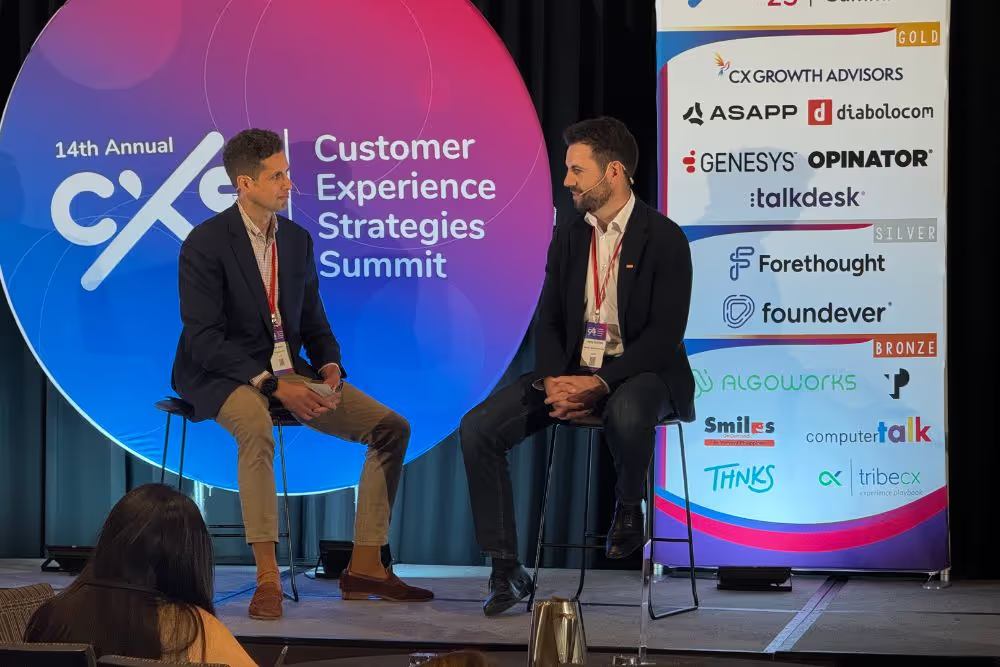
At the recent Customer Experience Strategies Summit (CXS), we sat down with Harry Clapham, Director of Operations Strategy and Enablement at Tangerine Bank, for a candid and insightful conversation on AI transformation in banking. The session touched on everything from hockey rivalries to governance frameworks, but the core message was clear: AI is no longer optional—it’s foundational.
Why AI? Why now?
Tangerine Bank, a digital-first subsidiary of Scotiabank, has already carved out a reputation for innovation. With 90% of its customers digitally active and a long list of accolades—including being named the top bank in Canada by Forbes—Tangerine isn't a laggard. But as Harry noted, “the fear of doing nothing is now greater than the fear of doing something with AI.”
Harry emphasized that customers today expect intelligent, responsive digital experiences. Nearly half of consumers are comfortable with AI-influenced decisions, and more than half would prefer interacting with AI over waiting for a human agent. For Tangerine, this is not just about cost—it's about meeting evolving customer expectations.
Strategy first. AI second.
A key takeaway from Harry’s approach: AI is not a strategy in itself. It’s a tool to serve a broader vision. Before implementing AI, Tangerine invested heavily in defining its long-term strategic goals. Only after aligning on “the what and the why” did they begin exploring AI as a method to get there. Harry's advice?
Start with the outcome. If AI is the best way of getting there, use it. If not, don’t force it.
Building the AI roadmap: Where to start
Tangerine’s journey began with foundational work in the chat channel, deploying a natural language processing (NLP) chatbot in the mobile app to handle FAQs. With over 50% containment, this early step created a solid data foundation for understanding customer needs. From there, Tangerine introduced human agents into the channel, enabling a seamless escalation path.
The final phase? Generative, agentic AI capable of handling more complex interactions—always with a “human-in-the-loop” safety net to ensure quality and trust.
Harry outlined four dimensions for prioritizing AI use cases:
- Effort & Cost – What’s the investment to launch?
- Impact & Scalability – What’s the potential ROI?
- Technology Readiness – Is the solution mature enough?
- Operational Readiness – Are people, data, and processes in place?
Choosing the right partner
In selecting ASAPP, Harry prioritized agility, accessibility, and actionable reporting. “We’re a smaller team,” he explained. “We needed a vendor we could interact with frequently, one that empowers us to manage the bot ourselves, and one with real-time reporting we could use for root-cause analysis and executive updates.”
Beyond day-to-day execution, Harry also valued ASAPP’s strategic input. The partnership helped Tangerine envision not just immediate improvements but long-term opportunities for differentiation.
AI, humans, and the contact center of the future
Harry envisions a fundamental shift in contact center operations—from cost center to value generator. Rather than replacing staff, AI creates capacity. That capacity, in turn, unlocks richer, more relationship-based conversations—whether it’s guiding a first-time homebuyer or offering personalized financial advice.
This transformation also demands a new approach to hiring, training, and org design. The contact center agent of the future won’t just handle routine queries—they’ll serve as strategic advisors powered by real-time insights and predictive tools.
Responsible AI: risk, governance, and regulation
Operating in a highly regulated environment, Tangerine integrates AI within Scotiabank’s enterprise AI governance framework. That includes early-stage risk reviews, model transparency, and strong collaboration with regulatory stakeholders.
Harry shared a framework for building internal buy-in:
- Active Listening – Understand stakeholder concerns.
- Challenge with Empathy – Reflect concerns and shift narratives.
- Collaborate Early – Bring risk teams in from the beginning.
What’s next for Tangerine?
The transformation is just beginning. Early results are promising: 91% intent recognition in chat, over 60% containment, and 80%+ agent adoption of internal knowledge tools. But this isn’t just about KPIs. It’s about redefining what a digital bank can be.
As Harry put it, “Imagine a world where the agent knows everything about the customer, is supported by AI suggestions, and delivers service that's fast, personalized, and deeply human. That’s what we’re building.”
Final words of advice
Harry left the audience with two key pieces of advice for AI change agents:
- Get excited – This is a once-in-a-generation opportunity.
- Match your message to the room – Don’t lead with excitement if your stakeholders aren’t ready for it. Lead with evidence, data, and empathy.
Tangerine’s AI journey isn’t just a case study in digital transformation—it’s a model for how to balance innovation with responsibility, and how to blend the best of AI with the best of human capabilities.
ASAPP recognized among notable vendors in Forrester’s latest report on conversation intelligence
The contact center tech stack is rapidly evolving, and conversation intelligence solutions are playing a critical role in improving customer experience (CX). Forrester’s The Conversation Intelligence Solutions for Contact Centers Landscape, Q1 2025 report provides a comprehensive look at 23 vendors in this space—including ASAPP.
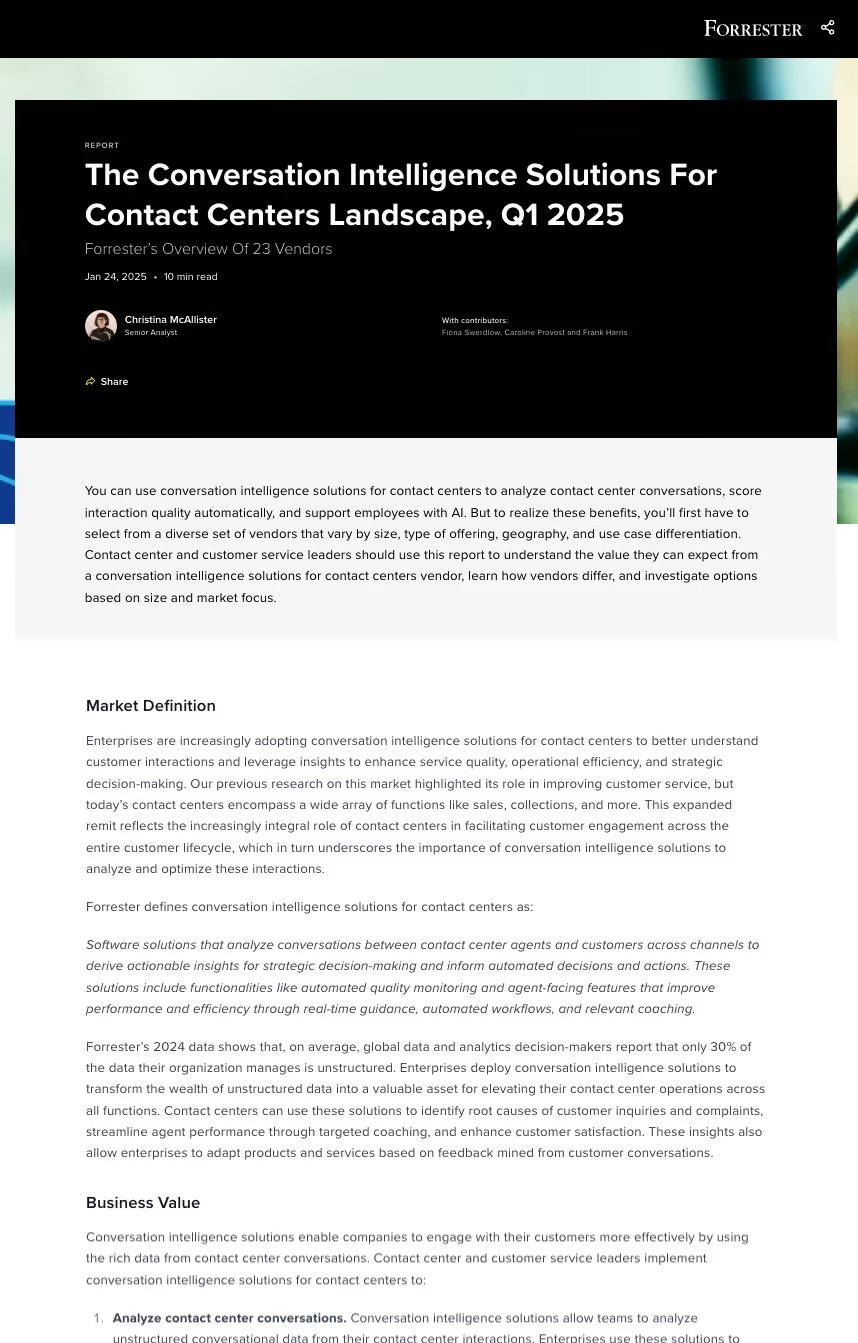
The growing need for conversation intelligence in contact centers
As customer expectations rise, businesses must find smarter ways to analyze interactions and empower agents. Conversation intelligence solutions help with real-time insights, automating call summarization, and improving customer interactions. Forrester’s report covers key market trends, vendor capabilities, and strategies for effectively evaluating these solutions.
According to the Forrester report, “Enterprises are increasingly adopting conversation intelligence solutions for contact centers to better understand customer interactions and leverage insights to enhance service quality, operational efficiency, and strategic decision-making.” The report highlights how these solutions help businesses transform unstructured data into valuable insights, enabling them to improve customer engagement across the entire lifecycle.
Core use cases for conversation intelligence solutions
Forrester identifies two core use cases for Conversation Intelligence solutions: improving interaction quality and efficiency, and uncovering the root causes of customer issues.
When selecting a vendor, Forrester recommends prioritizing evidence and demonstrations specific to your use cases to accurately assess each solution’s real-world effectiveness. The report also includes helpful tables to guide technology evaluation and vendor selection, advising businesses to select the use cases most relevant to their needs and prioritize the functionalities that matter most.
Turning customer conversations into actionable insights
Forrester’s report highlights how conversation intelligence is evolving to address modern contact center challenges, including the growing demand for real-time insights and scalable solutions.
Tools like ASAPP’s AutoSummary can help by reducing after-call work and making it easier to capture key insights. By providing structured data, free text summary, and customer intents, it further streamlines documentation and ensures insights are easily accessible. This means agents spend less time on paperwork and more time helping customers, leading to faster resolutions and better support experiences.
About ASAPP
ASAPP creates AI solutions that solve the toughest problems in customer service. Our solutions are purpose-built for CX on a core of native AI, so they go beyond basic automation to dramatically increase contact center capacity. We offer a range of automation solutions, including an AI agent that autonomously and safely resolves complex customer interactions over voice or chat. And when it hits a roadblock, it knows how and when to involve the right human agents.
With all of our AI solutions—including AutoSummary, which reduces after-call work by generating structured, high-quality interaction summaries—we help contact centers reduce labor hours while maintaining high first contact resolution (FCR) and customer satisfaction, all at the lowest total cost to own and operate.
Forrester does not endorse any company, product, brand, or service included in its research publications and does not advise any person to select the products or services of any company or brand based on the ratings included in such publications. Information is based on the best available resources. Opinions reflect judgment at the time and are subject to change. For more information, read about Forrester’s objectivity here .
Why wait? JetBlue’s blueprint for leading AI-driven CX transformation
What if the biggest obstacle to improving customer service isn’t technology, but the fear of jumping in before you're fully ready? In this final installment of our three-part series on JetBlue’s approach to generative AI in its contact center, Shelly Griessel, VP of Customer Support, shares her team's forward-thinking strategy for customer support and explores the realities of deploying ASAPP’s GenerativeAgent® (JetBlue’s Amelia 2.0). Her message is clear: don’t wait for the perfect conditions to start — the time to act is now, or risk falling behind, especially from a cost perspective.
You can also watch the full discussion. [link to full Wistia video].
Read Part 1, JetBlue’s CX journey: tackling challenges in an evolving industry.
Read Part 2, How JetBlue aligns costs, culture, and AI for CX success.
* Minor edits have been made to the transcript for clarity and readability.
Embracing generative AI to boost resolution and satisfaction
Dan: The way ASAPP thinks about it is that we're trying to build is something that helps improve the performance of agents, but also candidly to reduce the number of agents or labor hours or tier one interactions, whatever term you're using.
When you and I were speaking, you put it into a similar construct. And when you're thinking about AI, you're thinking about tech. You're looking at how I can improve and accelerate the performance of my crew members (JetBlue’s contact center agents), and how to reduce the pizza pie, so to speak, of the number of agents.
So take us through that. Because you are partnered with ASAPP, you’re using us for digital, for chat essentially, and live agent interactions all through digital. And then you've just recently deployed GenerativeAgent, or Amelia.
Take us through that journey of how you're improving the performance of an agent or accelerating the performance. And then you've introduced GenerativeAgent, or Amelia 2.0 recently.
Shelly: So the plan has been all along that we have to make the pizza pie smaller because that's how you bring costs down. We have to bring volume down. You have one shot at getting it right because if you don't get it right, then the customer will call back again and again. I mean, I don't know about your industries, but when a customer is not happy in an airline situation, they will call you back six, seven, eight, nine, ten times.
And that wastes money. So, the idea has always been that first contact resolution is a big deal for us, followed by CSAT.
I will never say we don't care about handle time, but we manage handle time as a separate entity altogether. If we are able to just shrink the pie by making the crew members more effective, we can push more of the really simple stuff to Amelia, and she will deal with it. I think now that we've got generative AI going, we really want to accelerate what she's able to do, and to have more of the bigger conversations with customers.
Understanding customer intents to optimize support
Shelly: I don't believe that Amelia should have the personality of being super empathetic because everybody knows she's a bot. So you have to be very careful that it still remains authentic, and she's not gonna ever be super authentic.
I think that the customer wants to get the job done as fast as possible, and get the right resolution that they're looking for. So we have to just keep on looking at understanding why customers are contacting us, and ASAPP has done an amazing job for us to explain the intent of our customers.
Once you understand that better, you can actually start looking at your product and say we need to make changes in the product. Why do they keep on calling about baggage? They don't like the baggage policy? Or checking in? They don't like that policy?
ASAPP has helped us a lot to understand the intents of why customers are contacting us. But that's all technology that is helping us shrink the pie.
Nobody, no company, wants to pay tens of or hundreds of millions for customer support. They don't. They want to invest the money in brand-new aircraft, and so they should.
We have an obligation to get a whole lot smarter about it. So our strategy is very much constantly evaluating our tech stack. Is it what it's what it's still needed? Do we provide them with enough information to be able to do the job? Like guided call flows. And making sure that crew members understand this is how it's going to help you versus anything else.
From proof of concept to progress: Teaching GenerativeAgent
Dan: I was thinking about this as you were speaking. I saw some great research. Shout out to Brian and Brooke from CMP on the research. I saw in a session yesterday around chatbots and voice bots just some dissatisfaction with customers and etcetera.
Everybody's familiar with that. When you dipped your toe into GenerativeAgent, or Amelia 2.0, what were concerns that you had going in? Because chatbots and voice bots promised a lot of the same things that you're hearing from a generative AI agent. And so what we hear a lot of is skepticism because we promised a lot, and it didn't necessarily happen.
So when you approached generative AI, how did you approach that to go, I'm going to see if GenerativeAgent, or Amelia 2.0, can actually work? And then tell us about the journey, trepidation, results, anything that you would wanna share about that.
Shelly: So we started in May when we said, okay, let's do a POC (proof of concept), and let's see how it goes.
And we had a team watching it and course correcting. I think you're familiar with the term hallucination. So she comes up with things that you go, why did you say that, Amelia? That's not true.
And then it's a matter of, okay, let's pull her back. Let's teach her how to do this differently. And I think that we've got enough – so this started in May. At that time, our containment with her was at about 9%. And then by August, she went up to as high as 21%.
And that's amazing in a very, very short period of time, and it's just a proof of concept. So it's very little volume that we're giving her, but I think that we now need to double down on this. I want to fast-track teaching her. I think that this has to come from taking some of our best crew members in the company and watching her and saying, “No, take that option away.” So there are certain things, for instance, that we learned that we don't want her to do.
There’s so much pressure on airlines at the moment to get your refund policies right. So the DOT is all over us. We can't let her make decisions on refunds. So we say, okay. Put that out of scope. What else is a hot topic? Like ADA, hot topic. Wheelchairs, hot topic. You have to keep that stuff out.
And I think that it's just going to take a little bit of time blending humans with teaching her on the areas that she can absolutely start knocking out of the park, and we'll get there. I think it just has to be this relationship made between humans and Amelia to learn.
I think that some of the companies that are getting some good success with it are taking a bot, whatever bot they have, and let the bot learn from a human. So I think that matching what great crewmembers can do with the bot is for us looking like that's going to be the future.
Start now even if you are not ready – or risk being left behind
Dan: A lot of the questions that we hear at ASAPP are, “I'm not ready for a GenerativeAgent experience because I've got knowledge base issues or technical debt” or any of those things.
If you were to give any advice to this audience about a place to start this journey – for people who are wanting to start on this AI journey but aren't ready to, like, deploy some sort of GenerativeAgent, where could they start? How do you evaluate?
Shelly: Your environment is never going to be right and ready. It's never. I mean, come on. For all of us that have been in customer support areas forever, every year we plan all the things that I'm going to do. And before you know, it's the end of the year. And I didn't do 50% of it because why? Because we come in and there's a new drama.
I think that the time is never right. I think that for this, in my mind, you have to jump in because I think if you don't, you're going to be left so far behind, especially from a cost perspective.
I don't think it's just airlines that are under the pressure for forecasts at the moment. We're going through budgets right now, and it's tough. Everybody wants customer support to cost nothing, and please make sure the customer is really happy still.
Don't spend any money, but don't you dare let that NPS go down.
I think we all know that, and that's why I say you've got to jump in and say, what have you got to lose? If you put the boundaries around it, what have you got to lose? You really don't.
So I don't think that you have the luxury of waiting for everything to be ready and perfect. You have to go, okay, I'm ready now. Now I can do it.
I think you're gonna be left behind if you do.
Read Part 1, JetBlue’s CX journey: tackling challenges in an evolving industry.
Read Part 2, How JetBlue aligns costs, culture, and AI for CX success.
How JetBlue aligns costs, culture, and AI for CX success
In part two of our blog series on JetBlue’s approach to customer service, we dive into the financial and labor dynamics that shape the airline’s contact center operations. Shelly Griessel, VP of Customer Support at JetBlue, offers a candid look at the factors driving up costs, from first-contact resolution challenges to the role of AI in improving efficiency. But it’s not just about numbers—JetBlue is deeply committed to supporting their workforce, investing in training, and fostering a culture where employees feel valued and empowered. In this post, we’ll explore how GenerativeAgent®, what JetBlue calls Amelia 2.0, is not just a tool for improving customer interactions, but a vital partner in alleviating burnout and keeping agents engaged.
Read Part 1, JetBlue’s CX journey: tackling challenges in an evolving industry.
Read Part 3, Why wait? JetBlue’s blueprint for leading AI-driven CX transformation.
* Minor edits have been made to the transcript for clarity and readability.
Understanding Cost Drivers in Customer Service
Dan: On cost reduction in the contact center, some will say, “okay, we're trying to reduce or maintain costs.” When you think of the financial aspect that either you or your peers are seeing, what is driving up that cost? Any insight that you have on what's affecting that?
Shelly: What's driving up the cost is that if you don't keep FCR at the highest possible level, customers will keep on calling back. And more volume means the cost of calls goes up.
So you have to try and find a way of doing two things in the customer contact center environment going forward. For us, it is bringing down the cost per call, and a big part of that is containment through conventional chat or now with more progressive, what we call Amelia 2.0 (powered by ASAPP’s GenerativeAgent).
We call our bot Amelia (after Amelia Earhart) because we had to give her a name.
We really like her. She shows up every day. She's got no absenteeism problems, never wants PTO, and she just shows up every day, and she's always friendly. She's, like, always friendly.
The Role of AI in Enhancing Customer Interactions
Shelly: So now we've got Amelia 2.0, which is gen AI, and she's a little bit more conversational, sometimes too much, but we're getting her there.
And I think that that is the next evolution.
We have to free crew members (JetBlue’s contact center agents) from having to deal with very basic stuff, and frankly, they get bored with it.
Our tenure is extremely long at JetBlue. The average tenure is about ten and a half years; they don't leave. But also the majority of our crew members are part-time.
So they work anything between fifteen and thirty hours a week. So that also helps with the lack of burnout. They don't burn out, and that's why.
But gen AI has got a massive role to play in this. It has a massive role to play in it.
Dan: When you're approaching the big topic of AI – something that’s so ubiquitous now that it's become very generic and losing a lot of its meaning and power – how are you and the team approaching those waters in the contact center space? What are the concerns and the outcomes that you're trying to get?
Shelly: So when we started really ramping up AI, there was obviously a massive fear by our crew members about “it's gonna take my job away.” And that was a very real fear for them.
And then they started realizing that she (Amelia 2.0) actually covers the shifts that they don't want to do. So Amelia became very handy. She would work weekends, and she would work through the night. So from that perspective, it became less of a threat for them because they knew that she was complementing them.
And our containment is extremely high. We started two years ago in the low 30s – 35, 36% containment. And now we're sitting at between 68% and 70% containment.
It just never gets past Amelia. Amelia keeps it. But when a call actually eventually comes over to the crew member, all the hard work has kind of been done already, and they can step in and just start making decisions that the customer is looking to be made. So for us, we've embraced AI as a company. Crew members are still more afraid of “will a BPO take over my job?” They're all more afraid of that than they are of AI now.
Addressing Labor Concerns in the Age of AI
Dan: When we talk about how agents are gonna lose jobs because of AI, I'm wondering why we aren't talking more about how agents are removing themselves from the job themselves and in record numbers. I think we are at 52-62% average turnover, major absenteeism, and the majority of contact center leaders are saying they are having a hard time recruiting.
I'm really interested in your thoughts on AI when it comes to this big issue of labor in the contact center and the high cost and absenteeism, and how contact centers are just dealing with that.
Shelly: We are proud of the fact that we don't lose people. But I think it's got a lot to do with the part-time model that we run. In fairness, there's a massive burnout level.
If you take call after call after call - and customers, let's be honest, they don't call in to say, ”way to go,” “I had a great flight,” “my flight was on time.” That's a given.
They don't. I mean, so every single call, call after call after call.
So we obviously manage it through the fact that they don't have these 40-hour week shifts, and they work part-time, so it makes for life to be a whole lot easier. But we also have a responsibility – and we spend a lot of time on culture. So we double down on culture. We watch our ratios of crew members to supervisors.
Maintaining Relevance in a Changing Workforce
Shelly: I was sharing with you earlier how much time we spend with crew members – what we call the PDRs, which is protecting the direct relationship that we have with them. It's a big deal for us. And we explain to them the why behind BPOs, the why behind Amelia. And the more they understand it, the better.
But the other obligation that we have in this industry is to make crew members or agents, wherever they are, relevant in five years from now because they won't be relevant if we don't make the effort. It's kind of our responsibility to do it.
And we have to teach them different scenarios of how to deal with de-escalation or really complicated problems. We have to, and that is where technology comes into it. Technology becomes their friend.
So I think we have a massive obligation and a responsibility to keep them relevant in the new world, and the communication has to be so big and so wide open to bring them along.
The worst thing that we can do is to make them feel disenchanted and they stay. Because if they stay, your customers will feel the impact of their unhappiness.
You've got an obligation. Employee engagement scores are huge in JetBlue. It's very, very big.
So we spend a lot of time on that, but I think that embracing technology as a part of it, we've never shied away from the fact that Amelia is there and this is what she does. These were her stats. We give them her stats on a daily basis because she's part of the team.
It's weird. She's not really a person, you know that.
Dan: Amelia is ASAPP's GenerativeAgent, but when she talks about it as Amelia, I'm like, yeah, she's part of the team. This nice woman in the front row said, “I wanna be Amelia's friend now.”
Fostering a Valued Workforce Culture
Dan: So, to put a finer point on it, because we are gonna talk about the tech part of this and the partnership with ASAPP later. Can you touch on what you are doing in the culture that you think, “this is going to have a really appreciable effect on keeping the crew members in the job?”
Shelly: People really want to feel they’re valued in the world. The feedback we constantly get from our crew members is that this is the first place I have worked at that I don't feel like a number. I'm not a number.
They've got access, and when we say they've got access to me as the VP, that is not just empty talk. It's real.
They really do have access. Every leader in my team has to dedicate two hours a week in their calendar for any crew member to talk to them about anything. Anything. And they blocked up those views.
We have monthly what we call "directly to you” meetings, in which it's open kimono. We tell them all the good and all the bad. The company is not doing well. The company is doing well. This is where we're going. Thhis is the good and the bad.
We've got a CEO that absolutely believes in 100% transparency. There's absolutely no point in sugarcoating anything. You have to be very honest with people.
And that's how we bring 24,000 people along with us. That is the total number of crew members that we've got in the company, but that's how we bring them along and how we protect the culture. So for the customer contact center area, we are not unionized, and there's no talk of being unionized because people know that things get done faster when they come to Shelley directly or their director or their manager to say, “I'm really not happy about this.” “What are we gonna do about it?” “Oh, well, this is why I can't do anything about it.”
So we absolutely believe in a very transparent relationship with them. We tell them the good and the bad all the time.
Read Part 1, JetBlue’s CX journey: tackling challenges in an evolving industry.
Read Part 3, Why wait? JetBlue’s blueprint for leading AI-driven CX transformation.
JetBlue’s CX journey: tackling challenges in an evolving industry
Customer support is not just about answering customer questions—it's also about resolving customer issues quickly, and adapting to rapidly changing expectations. JetBlue has been on the forefront of this shift, with a model that’s built on 25 years of remote work and a deep commitment to empowering their agents. In this post, part one of a three-part blog series based on a discussion between Dan Rood, SVP Marketing at ASAPP, and Shelley Griessel, VP of Customer Support at JetBlue, we explore how the airline’s approach has adapted to the challenges of a rapidly evolving industry, where the unpredictable nature of customer needs and agents’ lives can make every day a unique experience.
Read Part 2, How JetBlue aligns costs, culture, and AI for CX success.
Read Part 3, Why wait? JetBlue’s blueprint for leading AI-driven CX transformation.
* Minor edits have been made to the transcript for clarity and readability.
The unpredictable joys of contact center work
Dan: I'd love to hear from you - what is a moment or moments that occur to you in this industry in your role that you go, “I love this job. I love this.”
Shelly: I think without a doubt, it is the unpredictability.
We all think we've got our week planned out, we've got our day planned out, but it really doesn't work like that. I think that I love, love, love the fact that I've got absolutely no idea what's going to come at me today… And the unpredictability of what's happening in your crew members' lives (that's what we call our agents).
And it makes for just constant entertaining. Sometimes it's heart-wrenching stuff that you have to deal with. So we go permanently from a state of being absolutely ecstatic about life and, like, “we're winning every day” – and then they are just heartbreaking times.
And I think that's what I love most about the job.
I don't think… this is not what I planned to do in life, but just being in contact centers for so long, I think I've been blessed to have experienced so much over the thirty-five years that I've been in the business.
Why contact center challenges persist
Dan: If we were to go back five years or ten years, the conversation in any surveys that we have in a room like this, is that three or four things happen in a contact center – controlling, or even reducing costs, and improving CSAT, are the themes over and over again. And yet, in 2024, there's a lot of evidence to say it's not necessarily getting better. If you were to just step back, why does it feel like it is not getting better?
Shelly: I think to start off with, the last four to five years have made it exponentially harder. There's something that has just clicked in the mind of consumers that they're not tolerating as much.
It feels like it is a lot harder to please. And I think that people are also more than ever before stretched for time. There's just so little tolerance for long hold times, and then they get through to somebody who is not going to wrap it up quick enough.
I think the most precious commodity in today's world is absolutely time.
I am of the belief that they want to get an answer quickly. They want to get a consistent answer. If they don't like it, then they'll phone back three or four or five or six or seven times, until they get the answer that they're looking for. That drives up costs, that drives down FCR.
It's just a lot more complicated, and I think COVID has a lot to do with it. It has also got a lot to do with how much more challenging crew members' lives are. It is harder, and the value of the job hasn't gone up. So people are not necessarily getting paid more, and they're holding down two or three jobs, which makes their lives complicated.
Remote work and customer expectations
Shelly: In the JetBlue model, our contact center crew members work one hundred percent from home, and have since the beginning for 25 years.
In addition to that, as they work from home, they were challenged with, during COVID, being alone and having no contact with anybody else. So it's been a lot worse for them.
But I do think that for customers, it is a lot more about getting through to somebody that can give me an answer really quickly, and let me be on my way. And I want to do it when I want to do it, any time of the day or night. It's just a different experience that we have to offer customers today versus what it was.
Empowering contact center roles for speed and resolution
Dan: At ASAPP, we call it abbreviating customer pain. From a performance standpoint, the main threshold that you're trying to get to is speed and obviously real resolution. Is that the strategy when it comes to keeping brand differentiation with JetBlue versus your competitors?
Shelly: Absolutely. So we do want to speed it up, and we want to make sure that we use the human intellect in a different way than what we probably did three or five years ago. Which means that we are personally investing a lot more in the training and development of people to deal with the really tough issues. It doesn't help to say to a person, “You're empowered, and you can do what you need to do.” You actually have to teach them what empowerment looks like. So there's a lot more time and resources that we're spending on evolving the role of a customer support person.
And I do believe that the footprint of humans in a contact center is going to get smaller, but I think it's gonna finally become a higher paid role, because they're going to deal with a lot more complicated matters – a lot more complicated – and we should pay them more.
So I think the footprint will get smaller, but we should be able to pay them more.
Read Part 2, How JetBlue aligns costs, culture, and AI for CX success.
Read Part 3, Why wait? JetBlue’s blueprint for leading AI-driven CX transformation.
5 questions to ask before building your own AI solution for CX
The build vs. buy debate in software is nothing new. With the rise of large language models (LLMs), spinning up prototypes that can complete tasks has become easier than ever. However, developing an AI application for CX that’s scalable and production-worthy demands extra consideration. In this post, we’ll explore key questions to ask when deciding whether to build or buy generative AI solutions for CX.
While the right answer depends on industry, use case, and business goals, it’s important to carefully weigh your options.
Why building an AI application for CX requires extra consideration
The reason for this has a lot to do with the nature of generative AI.
Unlike most software development where the goal is to create a deterministic system with the same, expected outcome every single time, generative AI generates new information and content based on patterns, often producing varied responses that can be difficult to predict.
This variability is what makes gen AI applications so powerful, but also adds complexities in maintaining consistency and control.
Differing from standard applications where the workflow is predefined, generative AI models require continuous monitoring, training, and refinement. There is a misconception that generative AI just needs instructions. But in fact, they need much more, especially if you are training on your own data.
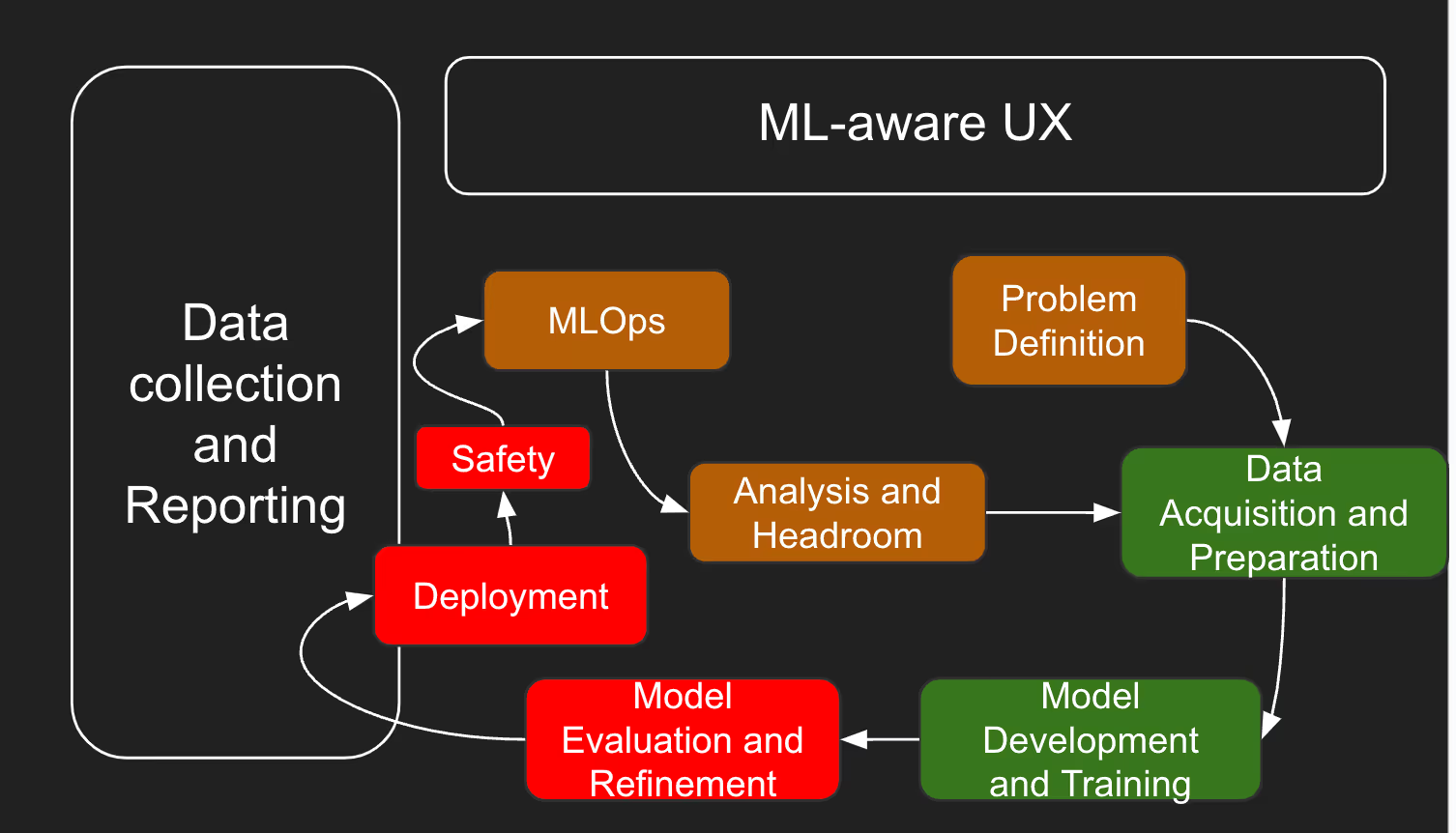
The flexibility makes them ideal for tasks that benefit from creative problem-solving or personalized engagement, but it also means that development doesn’t stop at launch. This, compounded by the fact that CX applications can ultimately impact a brand’s relationship with its customers, brings additional layers of considerations when deciding whether to build the application yourself or to partner with a vendor.
While the following is not an exhaustive list, here are some top questions you should consider when making a decision.
Is building AI applications part of your business objectives?
If building AI applications aligns with your business objectives, you’re likely prepared for both short-term and long-term investment in development and maintenance that will be absolutely critical for AI applications, ensuring the solution doesn’t become a burden on your resources.
In contrast, if developing your own AI applications isn’t a core objective, partnering with a vendor may be the more sensible approach. Vendors are equipped to provide solutions that fit your needs without the complexities of internal development, allowing you to focus on your primary business goals.
Based on McKinsey & Company’s recent estimates, building and maintaining your own foundational model could cost up to 200M with an annual recurring cost of 1-5M. Using off-the-shelf solutions or fine-tuning existing models with sector-specific knowledge can dramatically reduce this cost.
What’s your timeline for deployment?
If your deployment timeline is urgent—perhaps due to a competitor already leveraging AI solutions—working with an AI solution provider can help you hit the ground running and accelerate implementation. A vendor with solid experience in enterprise AI development will help you avoid unnecessary trial and error, minimizing risks associated with AI safety - such as AI hallucinations.
Instead, leaders should strongly consider partnering with gen AI solution providers and enterprise software vendors for solutions that aren’t very complex or [industry] specific. This is particularly critical in instances where any delays in implementation will put them at a disadvantage against competitors already leveraging these services.
- McKinsey & Company, in "How generative AI could revitalize profitability for telcos"
Do you have the internal expertise, resources, and infrastructure to build, scale, monitor, and maintain an AI solution?
While widely available large language models (LLMs) have significantly accelerated the process of building a working prototype on a laptop, this does not equate to having a production-ready, scalable solution that can effectively address your business needs [link to last mile]. Additionally, the demand for ongoing maintenance means that development does not stop after the application is launched.
Developing AI applications requires a skilled team knowledgeable in machine learning, data management, and software engineering, along with the necessary technological resources and datasets. Even choosing the right LLM to use for the best fitted use cases would require a good understanding of how various LLMs differ. Experience working with AI solutions is also crucial for successful deployment in an enterprise context.
In the last two months, people have started to understand that LLMs, open source or not, could have different characteristics, that you can even have smaller ones that work better for specific scenarios
- Docugami CEO Jean Paoli, in CIO “Should you build or buy generative AI”
If your organization lacks this expertise or the infrastructure to support such a project - not just at the prototype stage, but also to scale, monitor, and maintain the solution in the future - it may be more prudent to consider vendor solutions that can provide the capabilities you need without overextending your internal teams.
Also consider, if problems arise, do you have the manpower and expertise to investigate the root cause and implement long-term fixes, or will you be crossing your fingers and hoping the issues don’t recur? A strong internal team capable of addressing challenges as they emerge is necessary for ensuring the reliability and effectiveness of your AI application for CX. Without this capability, you risk operational disruptions and even diminishing trust in your brand.
What ROI do you expect from your AI application? And how comfortable are you with the associated risks?
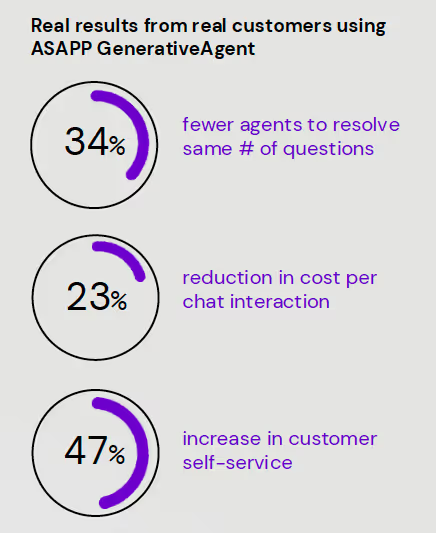
When considering your expected return from an AI investment, it’s essential to balance potential returns with the associated risks.
Agent-facing projects generally carry lower risks, as the AI solution won’t directly interact with customers. This allows for more trial and error, with agents able to provide feedback on the AI application’s performance. That said, such solutions might yield only incremental gains in agent productivity with less or no impact on the customer experience, and do not take advantage of the full capabilities of gen AI.
In contrast, customer-facing gen AI applications can offer a much better return because they can directly improve customers’ ability to self-service and, in some cases, resolve their issues directly. Here are the kinds of results a customer got when deploying generative AI agents with the capability to resolve Tier-one tasks.
Allowing AI to handle a broader range of tasks introduces added complexity. While there are risks—such as AI hallucination, where the system may generate incorrect or irrelevant responses—these challenges can be managed with the right approach. Having a strong internal team that can tackle this, or choosing an experienced vendor with a well-informed strategy for handling AI behavior, will ensure guardrails are placed around customer-facing interactions — so you can get the most out of your AI applications with confidence.
Making a thoughtful decision
Ultimately, the choice between building or buying an AI solution should align with your organization’s long-term vision. Each option carries its own set of challenges and opportunities, and taking the time to assess your specific needs can set the stage for success.
Considering the evolving landscape of AI, it's not just about deploying technology, but also ensuring that it fits well into your operational framework and readies you for the future. With careful evaluation, you can make a choice that enhances your customer experience. Whether you decide to build or partner, the key is to stay focused on your goals and embrace a strategic approach to generative AI applications.
Lessons learned from Altice’s successful digital messaging platform switch
Navigating any legacy platform transition can be nerve-wracking with little wiggle room for mistakes. As organizations increasingly adopt AI-powered solutions to enhance their customer experience, smoothing the process of switching platforms and optimizing user interactions requires careful planning, prioritization, and collaboration.
In the second installment of our two-part series based on a discussion between Melissa Price, VP of Customer Experience for Digital Self-Serve at Altice and Justin Mulhearn, Head of Solutions Engineering at ASAPP, we delve into the nuances of digital messaging platform transitions. Together, they share insights on overcoming challenges such as timing constraints, balancing automation with human support, and ensuring a smooth shift to a more advanced AI native platform. Through their experiences, they outline best practices for achieving long-term success while keeping user needs at the forefront.
Read Part 1: Why Altice switched messaging platforms: addressing flexibility, access, and support
* Minor edits have been made to the transcript for clarity and readability.
Adapting AI-powered messaging for user needs
Nick (moderator): We spoke earlier in the week, Melissa, about some of the ways we phased out the switch from your previous digital messaging platform to an AI native platform, or even just thinking about how to start and how to optimize over time.
I'd love for you to talk a little more in detail about how we got there, some of the things that were surprising, or moments when you had to prioritize this first, then get to other things later, while keeping the longer-term plan in mind.
Melissa: So some of the areas we delved into first were really about ensuring we're providing the right intent identifications, as we talked about earlier, and that we're in all the right places. The entry points were important to us to make sure we're there when customers need us and not just in the background, hoping the customer discovers us.
Being present in those moments that matter is something we continue to refine.
Whether that's in the app as backup support, leveraging chat there, or through our website, making chat available there. One example on the website is when customers are logged out and, say, they forgot their username or password and can’t log in to pay their bill. Being there in the moment to offer chat as the next line of support helps resolve the login issue or route them to an agent to resolve the issue more directly.
Balancing automation and human support
Melissa: Those were the types of things we wanted to uncover—what opportunities exist to drive more containment, where we can offer a quick reply or bot-based solution to the customer. Or if it reaches the next level of support, how do we identify those opportunities and get them directly to an agent?
Containment was definitely one of our goals that we reached, but containment in the right places and in the right way, I would say, not to misinterpret that stat. In some cases, containment is not a good option, and we need to rely on our chat agents to deliver the best experience.
Then there’s the surfacing of the entry point. Those are two big areas I’d highlight: intent identification and, up front, making sure customers can get to the right flow and resolution path as quickly as possible. That's also part of the consideration in terms of what's driving the AHT reduction.
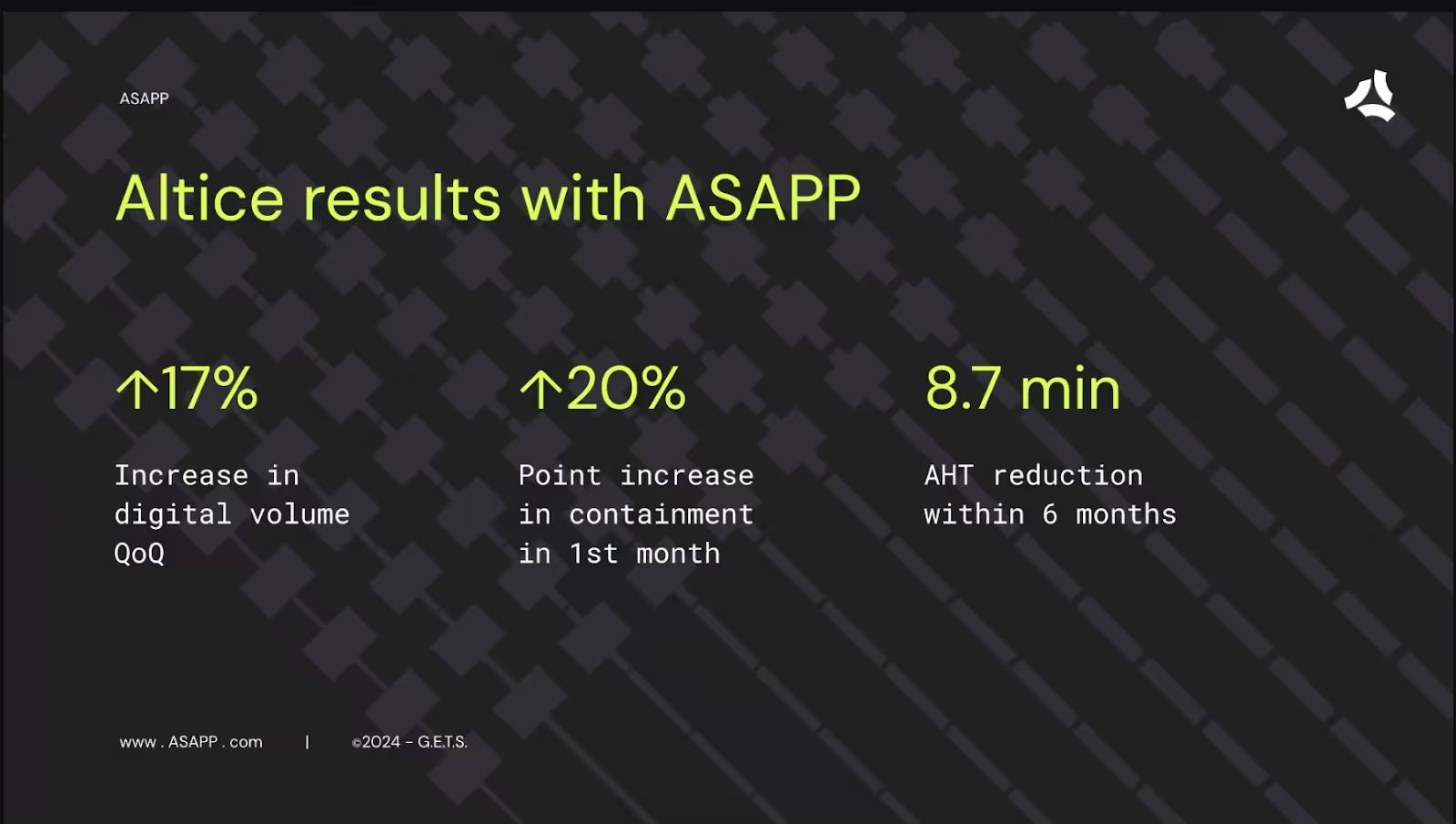
Nick: Yeah. It goes to the idea of focusing on the long-term gains. When you're optimizing and not pushing containment when it's not the right situation, that makes them come back to the channel, enjoy your brand, and have a delightful experience. So, thank you for sharing that.
Tips for navigating digital messaging platform transitions
Nick: But as I mentioned earlier, there's a lot of inertia. We know that moving a platform can be scary. Oftentimes, you're trying to manage timing considerations. So, I just want to say that we are mindful of the position you're in.
We've built it to allow you to get quick value and set up in under eight weeks. I know that’s a difficult thing for some other platforms to achieve, but you made the transition recently, Melissa. Justin, you've seen this a bunch of times. I’ll start with you, Justin. Do you have a few things in mind or some pointers on how to make these kinds of transitions easier, or even things people in our audience considering a platform switch should be thinking about?
Justin: Yeah, every situation's different, but thinking about some of the themes I’ve seen, the first piece of advice I would give is, at least in the beginning, skip the channels that aren't getting much use. I remember a couple of years ago when Google Business Messages was coming on the scene to compete with Apple Messages for Business, and everyone was excited about Facebook Messages as a support channel, and the same for Twitter DMs. If I look at 2024, those probably aren’t the areas getting the most attention. Google Messages is either turned off or soon to be defunct.
So I think about prioritization. If your customer base is in Latin America, WhatsApp should be your focus. If they’re primarily in the United States, maybe that’s not something you do on day one.
It’s about ordering priorities correctly and doing what will give you the biggest bang for your buck.
I would also say, as Melissa mentioned earlier regarding intents, you don’t necessarily need to replicate all your old flows when moving to a new platform. There’s definitely a place for classic deterministic flows. For something simple like, “What’s my bill balance?” you don’t need an LM to handle that. Sometimes, you may just want to navigate through a mini-system.
But as you look at your old deterministic flows, maybe you’ve got fifty in the old platform, but only need to bring over ten. For the rest, you can look to generative AI to handle those. Use that as an opportunity to save work and uplevel the experience.
The last thing would be embracing AI and machine learning for efficiency. Of course, I’m thinking about ASAPP’s platform here. There are many capabilities baked in, like giving agents a recommended response at the next turn of the conversation, or passing a question to a bot through automation.
There are opportunities like that, which are basically a training difference. It’s worth spending the time and giving agents the opportunity to use those tools so you can see that big efficiency bump as you transition.
Nick: Melissa, if I remember correctly, when we were engaging in that transition, timing was pretty important. I think we had a tight deadline. Could you tell us a bit more about that? And if you were giving advice to someone in the audience who’s in the same shoes you were in a year and a half ago, what kind of advice would you give them?
Timing for a successful digital messaging platform launch
Melissa: Yeah, I mean, that’s one of the more nerve-wracking things when you're transitioning — making sure you hit that deadline because you’re cutting off your old platform, and moving on to the new one, with very little wiggle room for mistakes.
What was important to us as we thought about the planning behind it was making sure that, between ASAPP, my team on the digital side, and our IT teams, we were all aligned on that plan.
We were all aligned on the timing and what the level of effort would be to do that. Grounding ourselves first on what was truly MVP for this launch, and making sure we took into consideration if it was just a like-for-like? Or if there was room for a like-for-better? Do we have room for like-for-better? So those were some of the things we were looking at, and then what the use cases were if there was an opportunity to augment the platform a little bit more on day one.
But then when it came to actual execution and delivery, just really making sure that you’re running point and the partnership - there is the important piece again to highlight that. But they said one of the things that we appreciated was the extra level of effort that kinda went into them, like, really leaning in on that transition plan and making sure that we were able to meet that deadline. It came from our teams as well.
People wear many hats when it came to that last two to three weeks time period to make sure that we got all of our testing done and passed on time. And, I mean, happy to report, we launched with no major defects. There was one defect that we had post launch, and it was a small one. So it was really because of the collaboration across the teams.
Nick: I love to hear that. I mean, it really was a collaborative effort. I love hearing stories of customers saying that we're a good partner in helping with that. I think it touches on something that Justin mentioned earlier. It's not just the product and the features.
It's actually the partner that you get in the platform vendor.
I think it's a big part of how we think of things and how we support our customers.
Why Altice switched messaging platforms: addressing flexibility, access, and support
Delivering a seamless digital customer experience is no small task—especially when existing platforms fall short. From limited automation capabilities to challenges with accessibility and support, organizations often encounter roadblocks that hinder both customer satisfaction and operational efficiency. When these gaps become too significant, making a platform transition becomes necessary.
In this first installment of our two-part series based on a discussion between Melissa Price, VP of Customer Experience for Digital Self-Serve at Altice and Justin Mulhearn, Head of Solutions Engineering at ASAPP, we explore the realities of switching messaging platforms. They share firsthand insights into the key pain points that led Altice to make a change, the biggest hurdles organizations face in these transitions, and how to approach the decision-making process strategically.
Read Part 2: Lessons learned from Altice’s successful digital messaging platform switch
* Minor edits have been made to the transcript for clarity and readability.
Switching digital messaging platforms: Altice’s experience
Nick (moderator): Melisa, you made the switch a little over a year ago. You were using another platform, and I understand Altice had some issues with it. I'd love to hear about some of the recurring frustrations you faced—or were there a handful of last straws that made you say, ‘Okay, we’ve known this was a problem, but now we have to make a change’?
Melissa: Yeah. Happy to share that. There are three areas specifically that I'll highlight.
One was around just the limited flexibility. Limited flexibility in terms of some of the insights that we were able to gather, and being able to go deeply enough to uncover the root of some of these opportunities, and how we would continue to grow in the chat space and deliver better experiences. And then how we present that to our customers and where we surface chat.
The other one was really around the access. Limited access in terms of being able to generate more flexibility for my team to then be able to make quick, continuous improvement efforts through the chat flows. And just making sure that we had the ability to really test and learn, and really make these real-time changes.
And then that last one, I would say, is just the engagement model.
If we were gonna start fresh with a new partner, we wanted to make sure that we had a better engagement model at the onset of it, and somebody who’s really looking at this as a partnership.
Nick: Justin, I know you've helped a bunch of customers make platform switches to ASAPP. Does this resonate? What else is common, or what are some of the other things you see in other platforms that hold them back from success?
Justin: Yeah, this definitely resonates. There are many inefficiencies and problems that we see as we’re working with these legacy platforms and programs. But to Melissa's point, oftentimes it's just about the account support. Sometimes it’s not even the technology.
But if your customer success team isn't there with you every single week, bringing you new features or really working with you on a continual basis, odds are the program’s not gonna reach its potential.
In terms of the programs themselves, this is both operational and technological.
I’ve seen a lot of programs out there that were never really optimized for digital and are still coming in with a voice mindset - If you have a program where you're taking chats, and it's a one-to-one concurrency like you had with voice, you’re basically getting no value out of the program.
But in a lot of programs, they tend to top out at a 1.2 to 1.3 level concurrency, and never really get beyond that. I think a lot of that does have to do with the underlying technology of the platforms themselves. From a basic perspective, you can have multiple concurrent conversations going on, but mental task switching between different subjects can be pretty difficult. So you really need the tooling and other support to help you shift rapidly back and forth between conversations as an agent.
The importance of context in customer experience
Justin: And I’ll also say that, from the end customer's perspective, when I see these legacy programs where there’s no context being passed from a bot to a live agent, that always drives me nuts. That drives me nuts as a customer as well.
And then, oftentimes, I find that even when it gets to the live agent, the agents aren’t empowered to do the same things that they could do on the phone, which is just the most disappointing. “Hey, I just spent ten minutes getting to this point in the conversation only to find out that the agent can't actually help me.”
I think, Melissa, you were talking a little bit about that earlier this week. How have you dealt with that agent empowerment piece?
Melissa: I think context is so important.
As you look at every handoff part of the process, making sure that you're delivering it through the lens of where the customer came from, and having a common understanding of what may have been attempted before. That's an area we're continuing to work on, but not something that would be solved overnight. But, the context is so important, and then how that ties in not just to the chat platform, but also the tools that our agents would use, whether it be on the chat side or whether it be on the voice side.
Keys to success in digital customer experience
Nick: Melissa, you’ve touched on some key aspects of what makes digital success possible. On the flip side, when you were considering making a switch to a new platform, what were the main things you were looking for in terms of both the engagement model and other key details to ensure success?
Melissa: We have a team that really is data focused, data led, and customer focused.
But I think when we’re looking at another partner for a chat solution, it was really important that the ideas and insights didn’t just come from my team, but also from whoever we’d be partnering with.
It was important to ensure that there were other insights brought forth proactively to help further understand different ways of thinking about the problems to solve. How do we uncover the root of some of these issues? What drivers may be behind containment, low containment, or poor experiences, as surfaced through NPS or other feedback from customers?
So, we were really trying to look at different angles to uncover opportunities and make sure we’re addressing the root causes. And then, partnering closely on finding a more optimized solution, based on key learnings from other clients or customers, with the potential to carry those insights into our work as well.
Nick: I know we talked earlier in the week about not just optimizing for digital, but even within digital, which I think really gets into how you best personalize and make the experience right for the customer in that specific moment and situation.
Melissa: Yeah, and if I could just share one specific example, it may seem small, but it can have an impact. When the customer is first interacting and engaging with us, initiating a chat, the intent is key. So, being able to uncover the right intent. We give customers the option to either select a list of canned intents based on our understanding of the context and entry point they may be coming from, or they have the free text option. But, it's about finding the right balance between how much we lean on the free text versus how much we’re continually updating and refining the canned intent list.
Those are things that we continue to cycle through to make sure we're delivering the best experience upfront, recognizing that when the customer’s trying to interact with us, we want to get them to the right place as soon as possible.
Watch the rest of the webinar.
